Chicago, IL
Artist-led projects in and about public space. If you were going to guide someone around where you live, where would you take them?
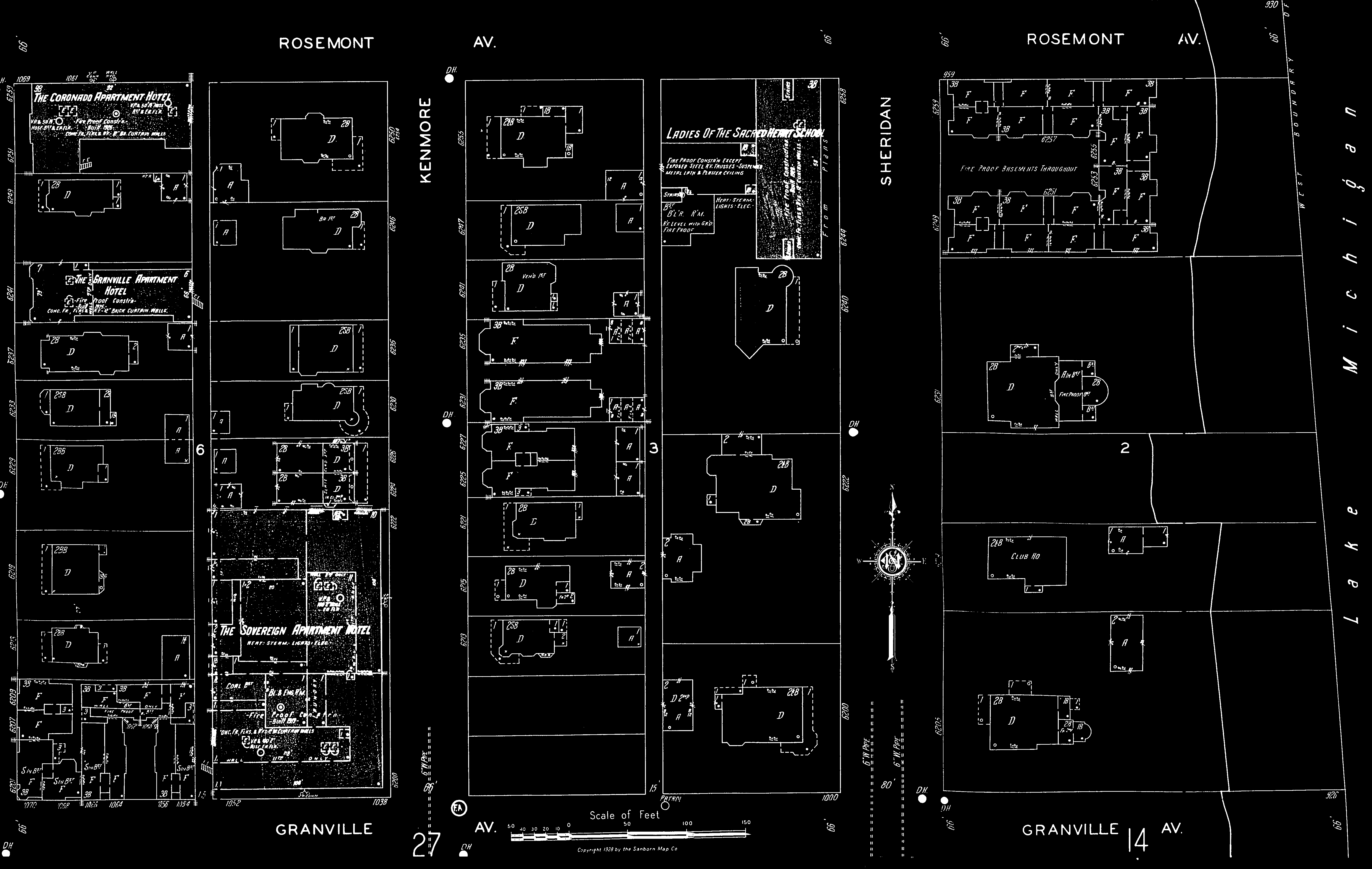
Ongoing
Dear Human by Christa Donner
What is a Tree? by John-Michael Korpal
1-833-NATR-XXX by Eliza Fernand
Shore Land by JeeYeun Lee
mille tendresse-mille fleurs by J. Kent
Umwelt by Mark Alcazar Diaz
A Girly Show by Jared Brown and AJ McClenon
Works-in-progress
Mari Miller, Veronica Anne Salinas, Hui-min Tsen, Liz Weinstein, JI Yang
In 2025, this program is supported by grants from the Illinois Arts Council Agency; CityArts grants from the City of Chicago Department of Cultural Affairs & Special Events; Cliff Dwellers Arts Foundation; Gaylord and Dorothy Donnelley Foundation; Reva and David Logan Foundation; Teiger Foundation; as well as in-kind support from Chicago Park District. In 2024, this program was supported by Hyde Park Art Center’s Artists Run Chicago Fund in partnership with Art Design Chicago, a citywide collaboration initiated by the Terra Foundation for American Art that highlights the city’s artistic heritage and creative communities. In 2023-24, this program were supported in part by federal assistance listing number 21.027 awarded to Roman Susan Art Foundation NFP by the US Treasury through the American Rescue Plan Coronavirus State and Local Fiscal Recovery Funds in the amount of $50,000, representing 17.5% of total project funding.
Dear Human
West Ridge Nature Park
5801 N Western Ave, Chicago IL
Dear Human is a multi-sensory guide through Chicago’s West Ridge Nature Park, activating messages from non-human residents: its pond, a deer tick, a tree, and others. This project merges narrated letters with recorded and existing soundscapes through site-specific prompts to touch, listen, smell, and find your place within the local ecology. Experience Dear Human starting at the entry gates of the park, or wherever you are in the world. West Ridge Nature Park is open dawn to dusk, year-round.
For collected materials, printable maps, and other work by the artist, please visit christadonner.com/dearhuman. These transmissions may be experienced as a GPS-activated immersive guide. If you prefer to navigate without GPS, audio and transcripts are shared below. To request a risograph folding map for this project, and for any questions regarding accessing this work, please write to dearhuman@romansusan.org.
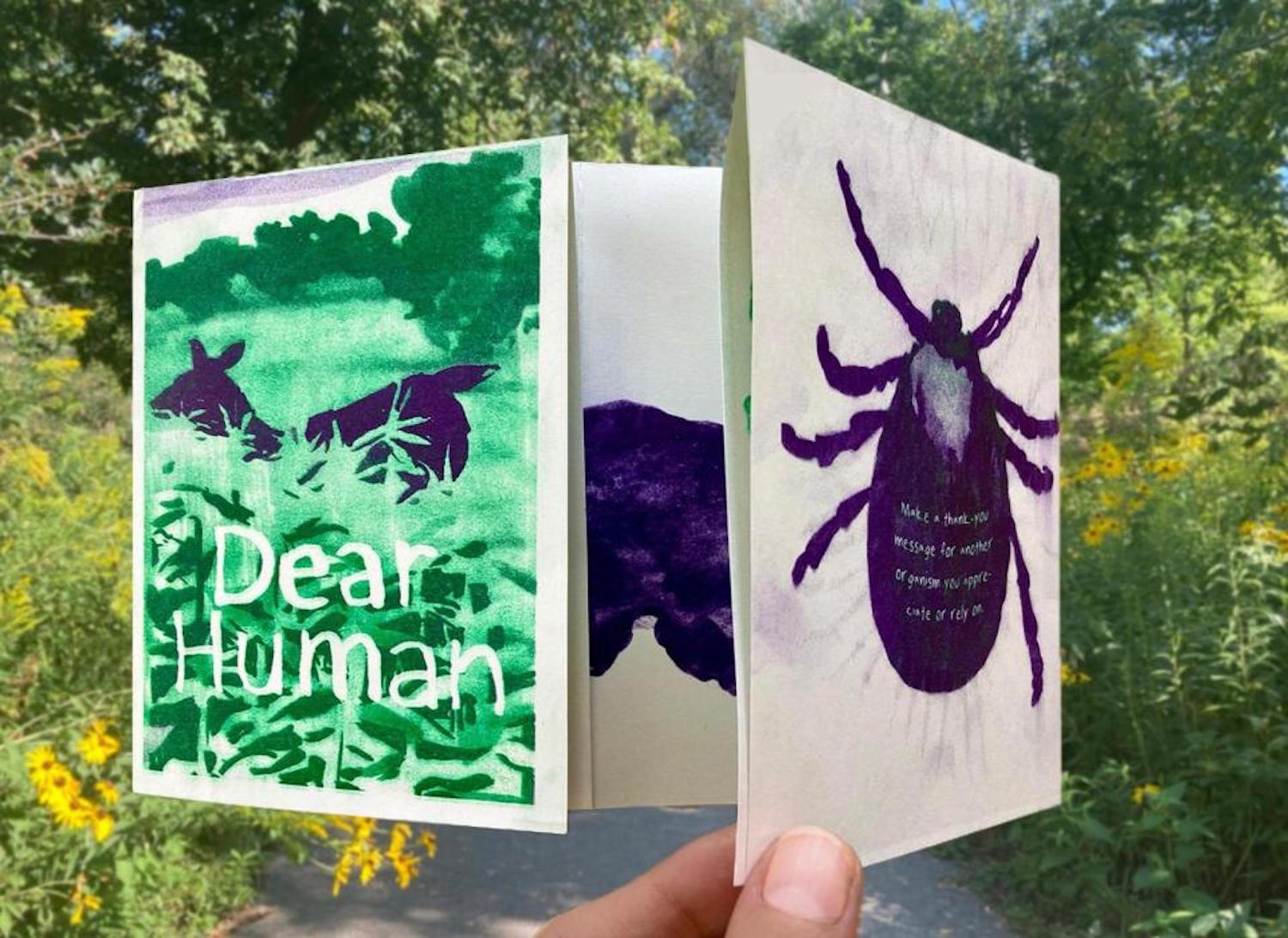
Welcome
(sounds of traffic, distant airplanes, crickets chirping, insects and birds)
Dear Human,
Thank you for meeting us here. Go ahead and start walking in any direction that feels right to you. //// This land is home to billions of beings. You might know us as milkweed, coyote, tree of heaven, brown bat, coneflower. We are the deer, the night herons, hackberry, bagworms, and bees. //// This walk is about all of us: the multispecies community of which you are a part. Maybe its become hard to hear our voices over themany sounds of your own species, which have become quite . . . loud. So we’ve worked with others of your kind to translate and broadcast transmissions through your phone, a tool that seems to focus your attention. As our honored guest here today, you – and every lovely living thing inside and on your body – have become a part o four family here. Let’s get to know each other better! //// When you are ready to listen, choose a location on your map, or a being you’d like to visit. Once you’ve reached a place where you can find one of us, select the corresponding track and press “Play.” As you walk between locations, take off your headphones and really listen for a while, without adding any sounds of your own. Smell the signals we send through the air. See if you can sense what we are saying without amplification. And along the way maybe you’ll find ways to transmit messages of your own.
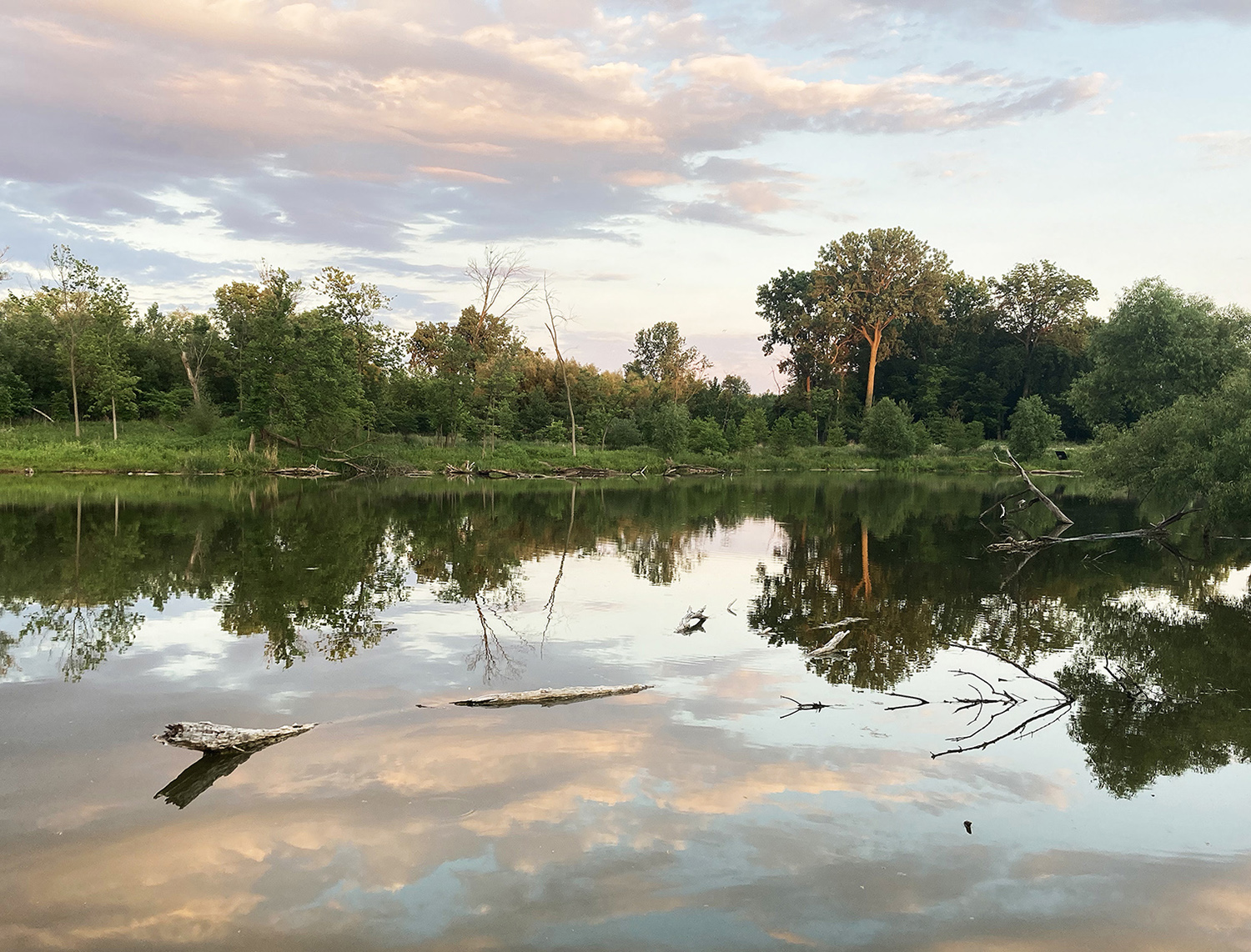
Pond
(water flowing, ducks softly quacking nearby)
Dear Human,
Look at you. Your body, reflected in my surface. All warped and crinkled up when the wind blows. All the stuff that’s tugging at you, just leave it here for a while. Let the ducks swim through it. //// Yesterday a family came by and I heard a snatch of conversation — the smaller one was telling one of the bigger ones about a dream she’d had. //// Maybe it sounds silly, but I hadn’t thought about that before: what are human dreams like? Do you ever dream about the ocean? //// Sometimes the sound of cars streaming nearby lulls me into sleep, and my molecules remember what it is to rise up as a huge, foamy wave, and to then sink down again. (Whshhhhhhh. Whhhshhhhhh. Whshhhhhhh) //// Look at me, dear human. Look at us. No, really. Look into me, past your reflection. There are places where you can see deeper, under a shadow or near a shallow edge. The shapes of my soft sludginess, of rotting leaves and old bottles. In this form my Pondness includes plants, sediments, calcium, fish. Under the surface there are more living things than you can imagine. I evaporate and condense over and over again, and eventually some of me will move through your body, too. //// Have you ever dreamed you could float, leave gravity behind? //// Of course you have. //// If we stand here long enough, we can all remember what it is to be a cloud. //// Close your eyes and feel the weight of your body. //// Take a deep breath in, and feel the tiny droplets of moisture all around you – and inside you, too. //// Breathe out, and feel the liquid in your body evaporate into the air above us with each breath. //// We are made of the same water. Water borrowed from the skies, from the rivers, from the winds. Through millennia the water that inhabits your body has been through the Mississippi, in icy mountain tops in Argentina, and in plant cells in Nepal. //// The water in you remembers all these journeys. //// As you mingle with other molecules, find your own strong memory of water. Feel its temperature and weight. Find the smell of it. //// I know this part of you well. I know the rain, just as I know the water in your bathtub. //// They travel through soil, through chemical filtration, through living bodies. With every cycle something is added, and something is taken away. We all feel it. Microscopic messages from landscapes and bloodstreams. Limestone and iron oxide, medicines, plastic residue, drain cleaners, laundry soaps. The water is changing. And all the organisms that need water to live, you are changing too. //// The smallest droplets have gotten heavier with the weight of remembering, and as they join together they begin to fall. As you return to your human body, let the fluid move with the memory. Send a signal to let us know what you’ve found.

Deer
(grass and twigs snapping underfoot, hearbeat, birdsong)
Dear Human,
Hello. Please, keep walking. //// Oh! Hi, you’re still there. Please, keep walking – don’t try to look for me. (whispered) I’m not interested in becoming your friend. I know it excites you to encounter another large animal here. Hearts beating, not afraid to look you in the eye. Maybe you should stop to think for a moment about why that’s so unusual. //// I remind my young to keep their distance, stay alert, and be ready to run, just in case. //// Maybe you should be more alert. //// Stop. Stand still for a moment. Did you hear that? //// Scan the patterns of light and dark for movement. Breathe. //// Sometimes humans bring their dogs in here. It can be really stressful. Once I took my children out beyond that fence over there, and honestly, I don’t understand what you all think you’re doing. Broken sharp things, loud sounds and bad smells. That stinking river of cars. Nothing growing except in little patches. It made me very nervous. //// Oh, someone’s coming. Come on, let’s keep moving. //// There’s really no privacy here for animals our size, but at least there are good food options. Take a closer look – can you see the line of ripped off leaves we’ve been eating? Those are the best plants, but I’m sure you can find something higher up. Have you tried the acorns here? //// I’m gonna leave you here now – this is making me hungry. //// Take care of yourself.
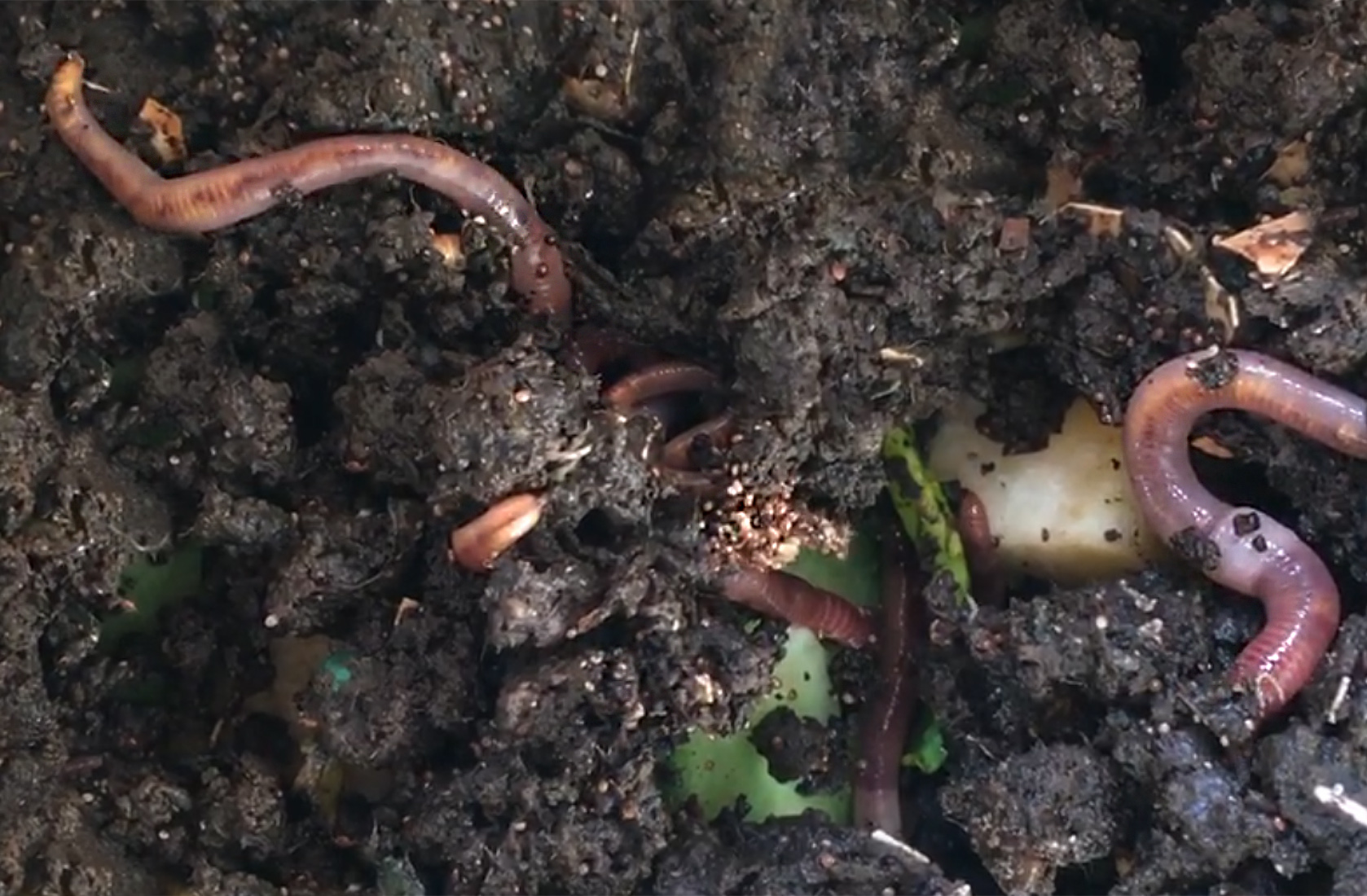
Humus
(worms moving through wet soil, deep vibration, children playing)
Dear Human. Dear Humanananan,
I am Humus. I am living soil. My mothers move through my body, their breath and decomposition bringing heat even when the air is cold. They caress and soften and rot, pulling everything apart and mixing it up together again until we are all one, moist thing. //// (inhales deeply) //// Mmmm. . . . I smell your familiar scent, little human. Can you smell me, too? Don’t be afraid. //// Press the tip of your shoe into my spongy surface. Scrape a mark to open me up. //// Now kneel down, and inhale the scent of my molecules. Run your fingers through me, like the children do. Breathe me in. //// My beautiful bacteria need no words. As you inhale they send out calming signals to produce serotonin in your brain. Gamma-proteo-bacteria boost your immune cells. //// I share what I have with many beings, until they drop leaves and seeds and collapse into me. Lay their eggs and die. They shove and shape me into who I am – who we are. We lie still together through the cold times until the sun warms us up and everything begins to change again. //// Over there past the fence, your dead return to me too, nestled deep within my folds, among the bodies of birds and opossum and others. All of them tended by millipedes, worms, and fungi. The calcium of buried bones feeds seedlings, brings new life. It happens over and over and it feels. So. Goood. //// And over here, your young are learning how to be a part of this world, touching and sensing and finding where to burrow or balance, when to let go. //// The trees are great teachers, aren’t they? //// Don’t tell me you’ve forgotten. //// What else have you learned from the land? //// Whose bodies share their nutrients with yours, provide warmth and shelter? //// We called you here to find groundedness. Together we can make many things grow.
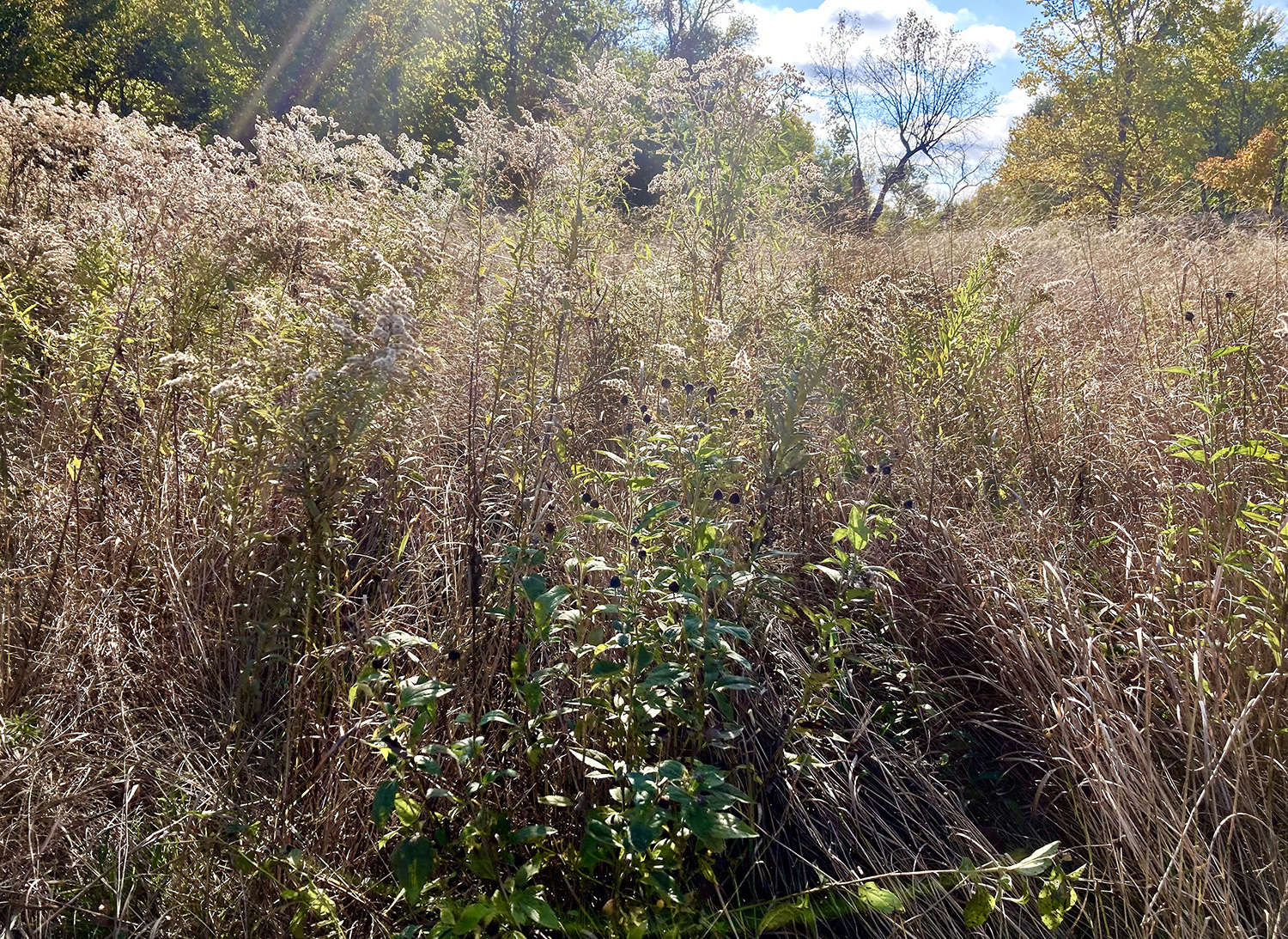
Tick
(footsteps in tall grass, crickets and birdsong, traffic)
Dear Human,
Why don’t you reach out your hand? Touch the tips of the tall grass as you pass. By the time you get this message, I’ll be gone. It’s safer that way. //// But I wanted to let you know that you were a great host. It’s not always that way. I’m really glad you made some time to come on over here. //// When I was just a nymph I fed on a rabbit, somewhere out there. I drank deeply, belly full of his blood. After that it was a long time before I could find another meal. Most of the larger mammals kept to the hard, gray paths, and the grasses were clipped much too short. Thank goodness for mice and their wanderings, you know? Somehow we wound up in this park, which seems like a fine place to settle down. //// Do you want to know my first memory of you? I was hungry, and I was waiting. Just hanging out at the top of one of those tall stalks of prairie grass with my forelegs in the air. Then I caught your scent. “Wow,” I thought. “Wow.” //// I figured you’d just stay on the path and walk on by. I tried to put you out of my mind. Thought about other animals who might wander along if I just waited a few more hours. And then, suddenly, there you were – leaning in for a closer look at a bird or a plant or something. I stretched out and grasped your body just before you moved off. (sigh) So lucky. //// So. Did you have a good walk? As we moved on together, I dug in my mouthparts and had the best meal I can remember. And not just because your blood is delicious . . . though oh my gosh, it really is. My eggs are almost ready now, and I guess what I want to say to you is - Thank You. Thank you for sharing what you have. With me, with the next generation. Just being here you’ve given back more than you know to this ecosystem, and I bet to many others as well. //// I want you to know that you are appreciated. I hope you have a great day.

Tree
(trees creaking and rustling in the wind, birds singing in the distance)
Dear Human,
Hi there – it’s me over here. The large tree just next to the path. //// Listen. We have a quarter of our DNA in common. I think we might have some things to say to each other. //// Could you step a little closer? //// Place a hand on my bark. It’s hard to feel you over there. //// That’s better. //// I’ve got a question for you: How would you describe your relationship with Time? //// (pause) I’ve always wanted to ask that, but we seem to exist at such different speeds that usually you’re gone before I can get the question out. //// This has been a tough five or ten years. I’ve lost some good friends. We’d look out for one another – tip each other off when the bagworms were coming back, or if a polar vortex was moving through. Sometimes we’d just joke around. It’s hard to see pieces of them stacked up along the gravel road back there, their limbs cut off. //// You seem like a good listener. //// There are advantages to putting down roots. We share messages and memories across so many miles and thousands of years, in every direction. Lean into discomfort and feel it deeply. Consider which actions will mean something to those who’ll live generations from now, after our bodies have been turned into paper bags or mulch. //// I want to show you something. Just stand still here with me. //// Relax your limbs, relax your focus, and imagine that below your feet, tiny roots are burrowing down. Can you feel them? //// Close your eyes. Can you hearl the sound of my branches overhead? That’s all you need. Now let that reverberate down your trunk, and into the soil below your feet. //// Can you feel that? It’s like a mirror underground, branches reaching out into the layers of the earth. Traveling past rocks, and the remains of older and older things. //// Down here, time is only connected through threads of mycelia. There’s no light at all. The earth presses in on all sides. //// Extend a root tip toward that hard thing to your left. There’s a chunk of something there, centuries closely packed together. If you stay in contact long enough, it’ll tell you its stories. //// But for now, let’s return to the surface, traveling back up through your trunk, and higher, toward your crown. Lean your head back, and open your eyes. Look into me. //// Every one of my limbs splits into branching points, smaller and smaller. Every branch is a choice, a possible future. //// Spending slow time here, in between the past and the future . . . is kind of the point. //// When life moves a little too fast, I’m here. Feel free to come sit with me, if you need help slowing down. I can be a good listener too.

For many years the land that is now the West Ridge Nature Park served as a dumping ground for debris as part of one of Chicago’s oldest cemeteries. During its renovation as a public park in 2013, artifacts revealed it to be part of an enormous precolonial Native American village, and a center for trade, travel, and healing for tribes including the Potowatami, Miami, Kickapoo, and many others. Dedicated as public park space in 2015, the Nature Park is a 21-acre oasis in the heart of the city, supporting native plants, birds, amphibians, deer, and other wildlife including a dedicated community of humans.
Christa Donner is an artist and organizer whose practice combines material exploration and social exchange to move between the emotional architecture of our own bodies and the layered histories of the world we inhabit. As a volunteer at West Ridge Nature Park she helped to redesign its nature play area in 2018. Donner's work is exhibited widely, including projects for the Max Planck Institute for the History of Science (Berlin, Germany), The NTU Centre for Contemporary Art (Singapore), Chiaki Kamikawa Contemporary Art (Paphos, Cyprus), and throughout the United States. For more information, please visit christadonner.com.
This work is a part of Navigations, a series of artist projects in and about public space. This work is being shared at West Ridge Nature Park in alignment with The Available City as a partner program of the Chicago Architecture Biennial. An expansion of this work has been created for the Tryon Farm Institute in Michigan City, Indiana. In 2025, this project was supported by grants from the Illinois Arts Council Agency; CityArts grants from the City of Chicago Department of Cultural Affairs & Special Events; Cliff Dwellers Arts Foundation; Gaylord and Dorothy Donnelley Foundation; Reva and David Logan Foundation; Teiger Foundation; as well as in-kind support from Chicago Park District. In 2024, this program was supported by Hyde Park Art Center’s Artists Run Chicago Fund in partnership with Art Design Chicago, a citywide collaboration initiated by the Terra Foundation for American Art that highlights the city’s artistic heritage and creative communities. In 2023-24, this program were supported in part by federal assistance listing number 21.027 awarded to Roman Susan Art Foundation NFP by the US Treasury through the American Rescue Plan Coronavirus State and Local Fiscal Recovery Funds in the amount of $50,000, representing 17.5% of total project funding.
‘Dear Human’ Audio Tour Narrates West Ridge Nature Park’s Story From Perspective Of Its Non-Human Residents | Block Club Chicago - December 2, 2021
What is a Tree?
Warren Park
What is a Tree? launched on Arbor Day 2023, and was followed by guided walks on Arbor Day 2024 and 2025. We encourage you to experience this project on your own by finding a Mother Tree in the northeast corner of Warren Park, and proceeding along the walking path clockwise (to the left) at the first branch. What is a Tree? prompts you to observe, interact, personify, and engage with the arboreal inhabitants of the park. Below is a growing body of resources to help relate to and learn about trees.
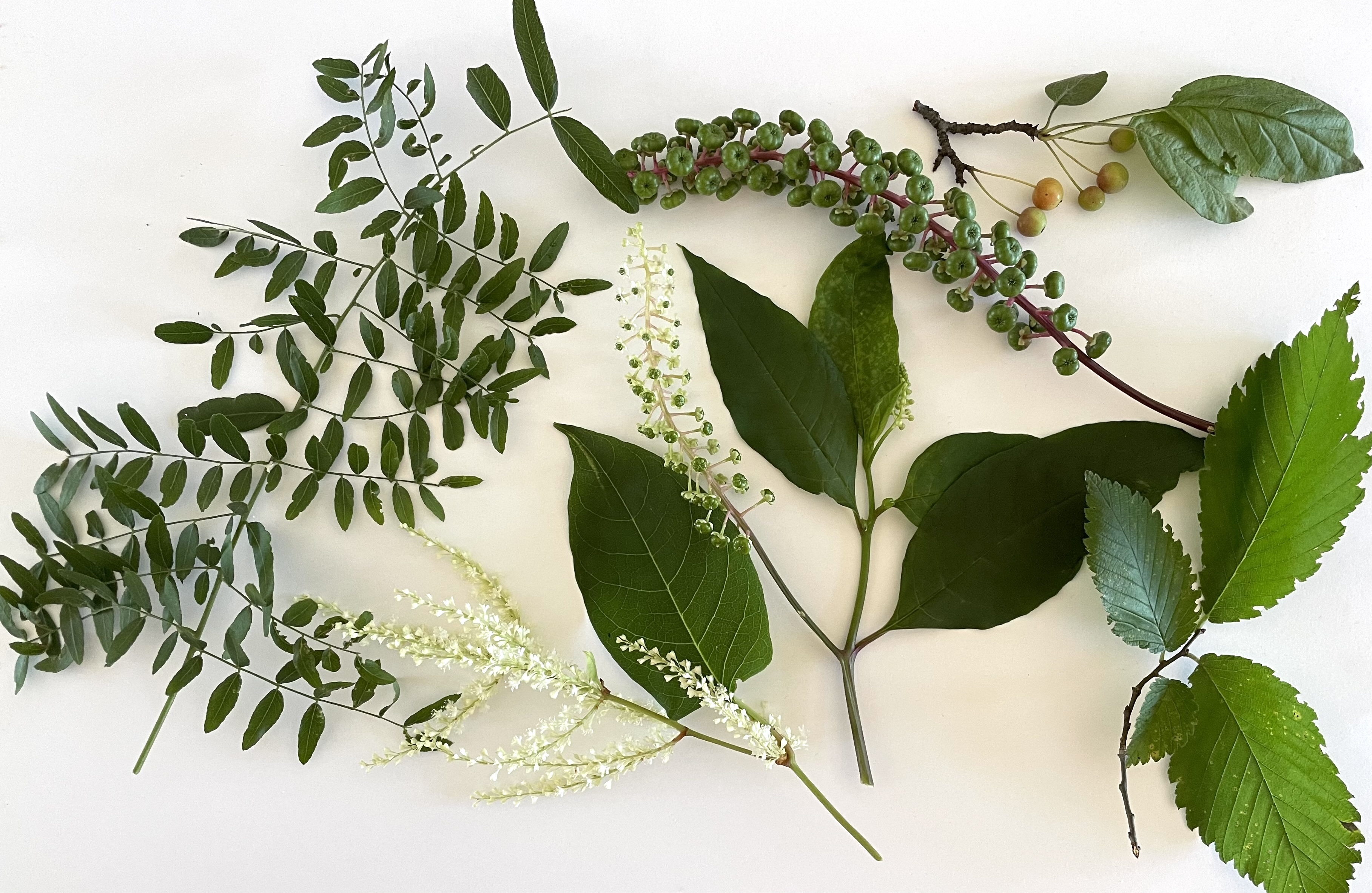
We acknowledge that the Chicago we know sits on the unceded ancestral lands of the Council of Three Fires: Ojibwe, Odawa, and Potawatomi as well as over a dozen tribes including the Miami Nation, Ho-Chunk Nation, Menominee Tribe, Sac and Fox Nation that called this land home. We explore this land with respect of the past, present, and future, for reparations for the harm that was allowed to occur.
The image above includes leaves and fruit from Warren Park. Do you know what trees they belong to? Below is a birch catkin on one of the trees along our path.

Tree . . . as a Verb
(for a group)
Trees are often thought to be Tall, Strong and Silent appearing to be dormant and inactive part of year. To be a Tree is to be in constant motion. Creating and storing food and energy for survival and growth. While contributing to the well-being of surrounding trees and organisms.
I invite you to Be a Tree:
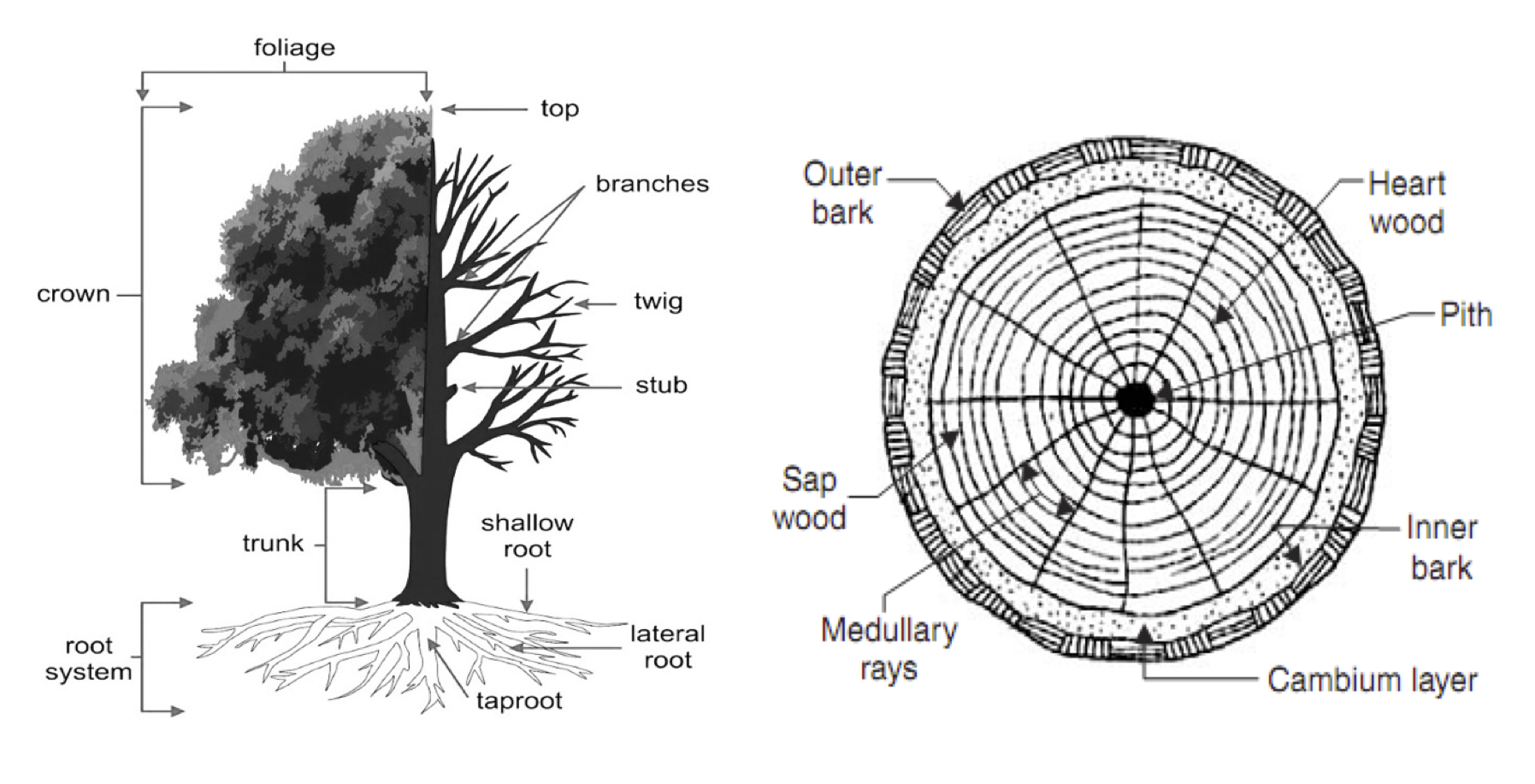
Heartwood
Individuals hold arms up to show muscles and stand in the center facing outward. Chant: “I Support, I Support” (repeat)
Taproot
A single individual sits at the base of the heartwood. This person represents the deep taproot that most trees have. Make slurping noises.
Lateral Root
Individuals lie on their back in the circle with feet facing inward towards the Heartwood. Make slurping noises.
Sapwood / Xylem
Individuals join hands and encircle between the lateral roots facing the Heartwood. Individuals should pretend they are drawing up water from the roots raising joined hand above their heads and then lowering. Chant “Whoosh, Whoosh” (repeat)
Cambium
Individuals join hands around the Sapwood. Chant: “We Make New Cells, We Make New Cells” (repeat)
Phloem
Individuals join hands around Cambium Individuals will raise arms and lower. Chant: “Food to The Tree, Food to The Tree” (repeat)
Outer Bark
Individuals form a circle around entire tree facing outward holding hands. Individuals should growl and pose like football players to defend the tree. (repeat)
Here is an example of this formation, from Arbor Day 2023:
The more of you, the better 🌳
You might notice that our friends in the photo above who are Being a Tree all have little brown bags. For our first What is a Tree? event on Arbor Day 2023, these little packages where gifted to our group of navigators to help explore the park. Here are some things that were included that you can assemble as-needed when you visit the trees of Warren Park (or anywhere):
1) String to measure and compare the different sizes of tree trunks;
2) Tree . . . as a Verb, in case some friends show up to join you;
3) Bag of raw peanuts for the “Squirrel Tree” and other squirrels you may encounter on your journey;
4) Pencil;
5) Annotated map – or a blank one to fill in yourself;
6) Journal to capture thoughs, ideas, and dreams in the moment while they are still fresh.

When I was growing up, they offered friendship without judgement and a place to safely explore and dream.
I would sit with them for hours sharing in the silence constantly amazed by the different shapes of leaves reflected in the light and the texture of the bark . . . and the random ant determined to complete their task.
As an adult I have walked through Warren Park many times. The trees have shared their strength and silence as they helped me find balance and serenity.
This is my way to say Thank You to the trees and share their energy and spirit with you. To remind you to be well rooted in the ground, standing tall as you reach up to the sky… and always remember to whisper your dreams to the leaves so they can be carried off into the wind so the seeds may take root in fertile soil.
Trees are Home to many different life forms.
Some benefit the Tree.
Some co-exist with the Tree.
Some are harmful to the Tree.
What are some of the different life forms you might find in the park?
What might their homes look like?
Are they in plain sight or hidden?
Look up towards the sky.
Look around the tree.
What might be hidden under the ground?
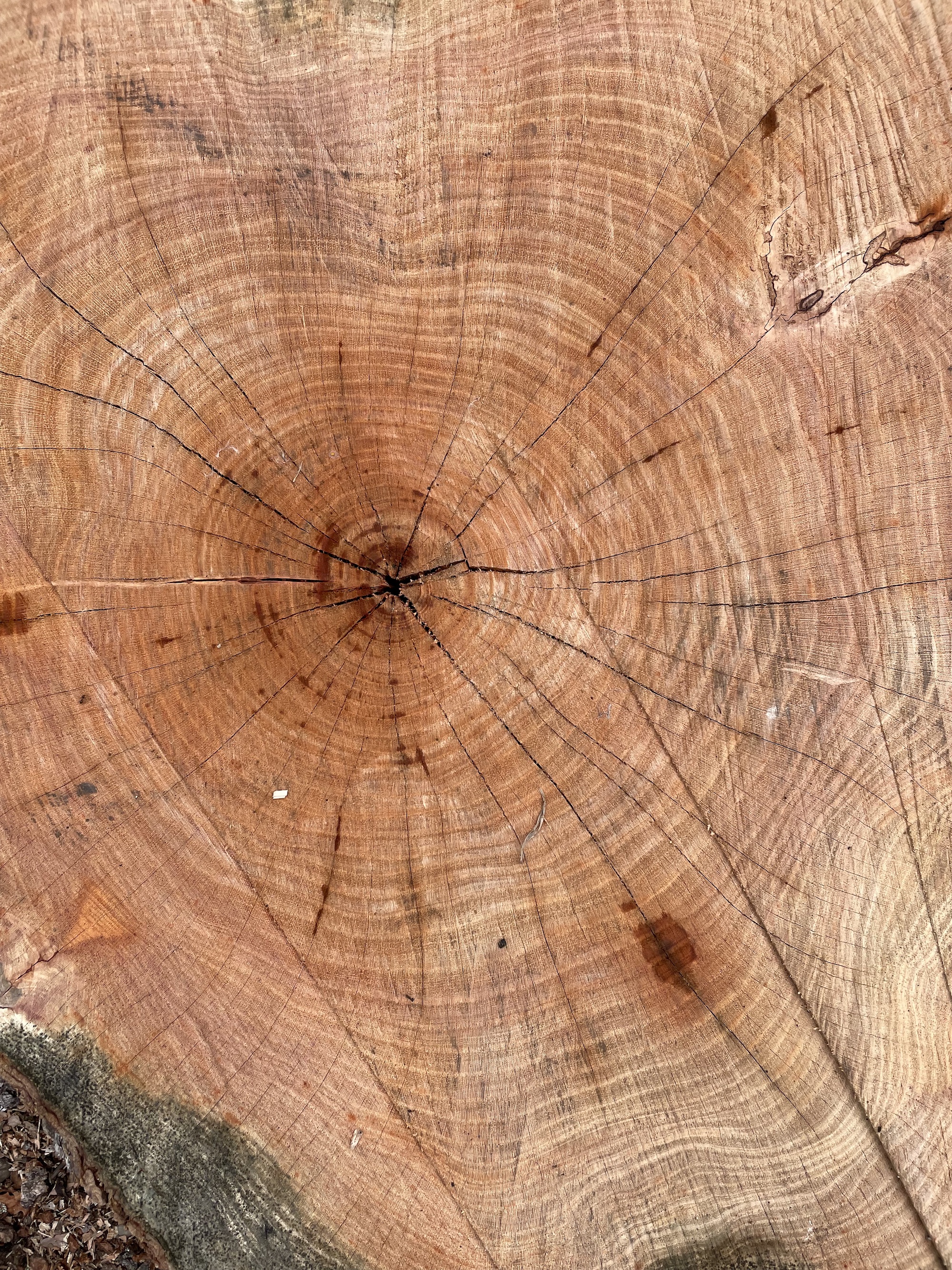
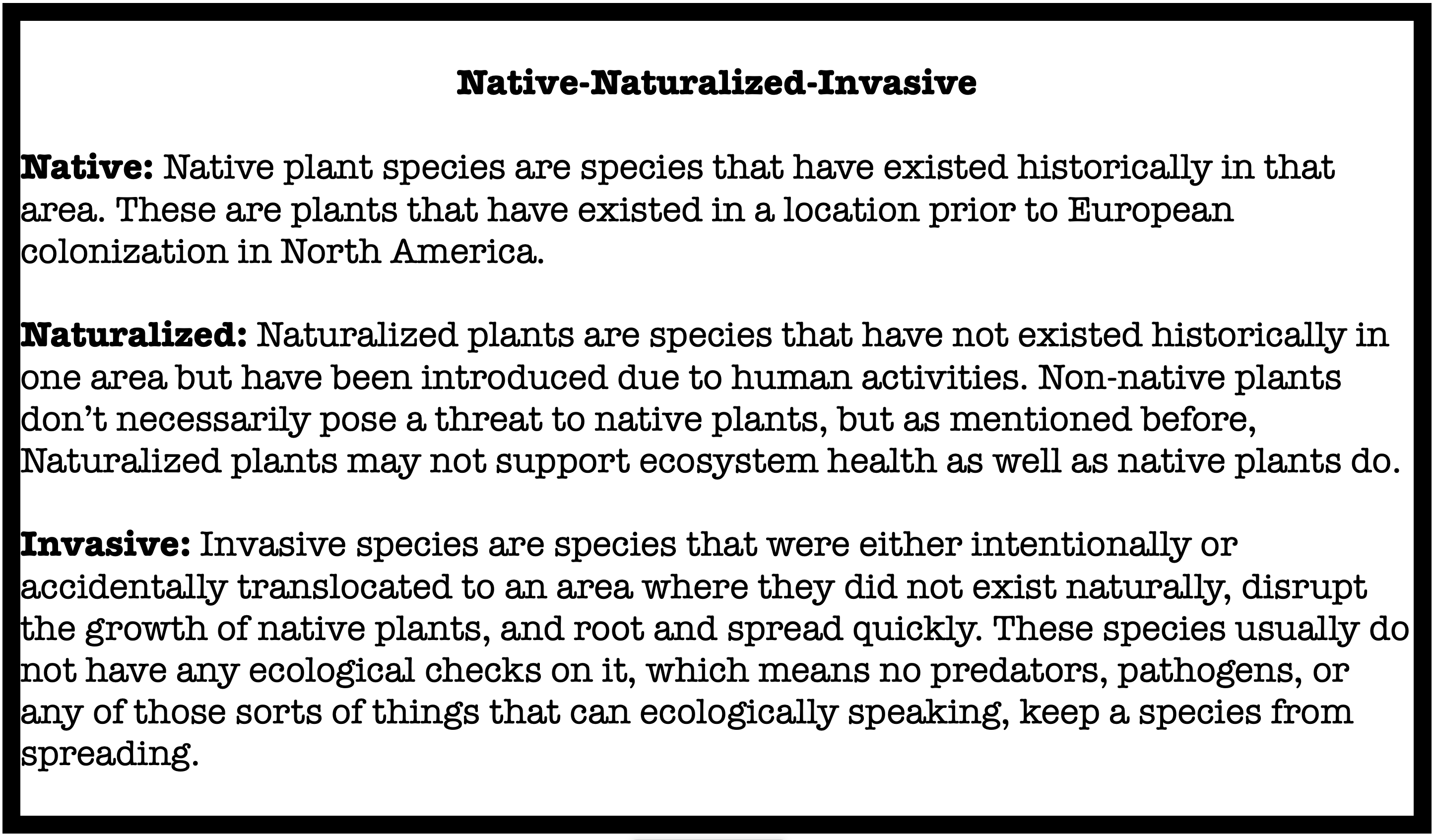
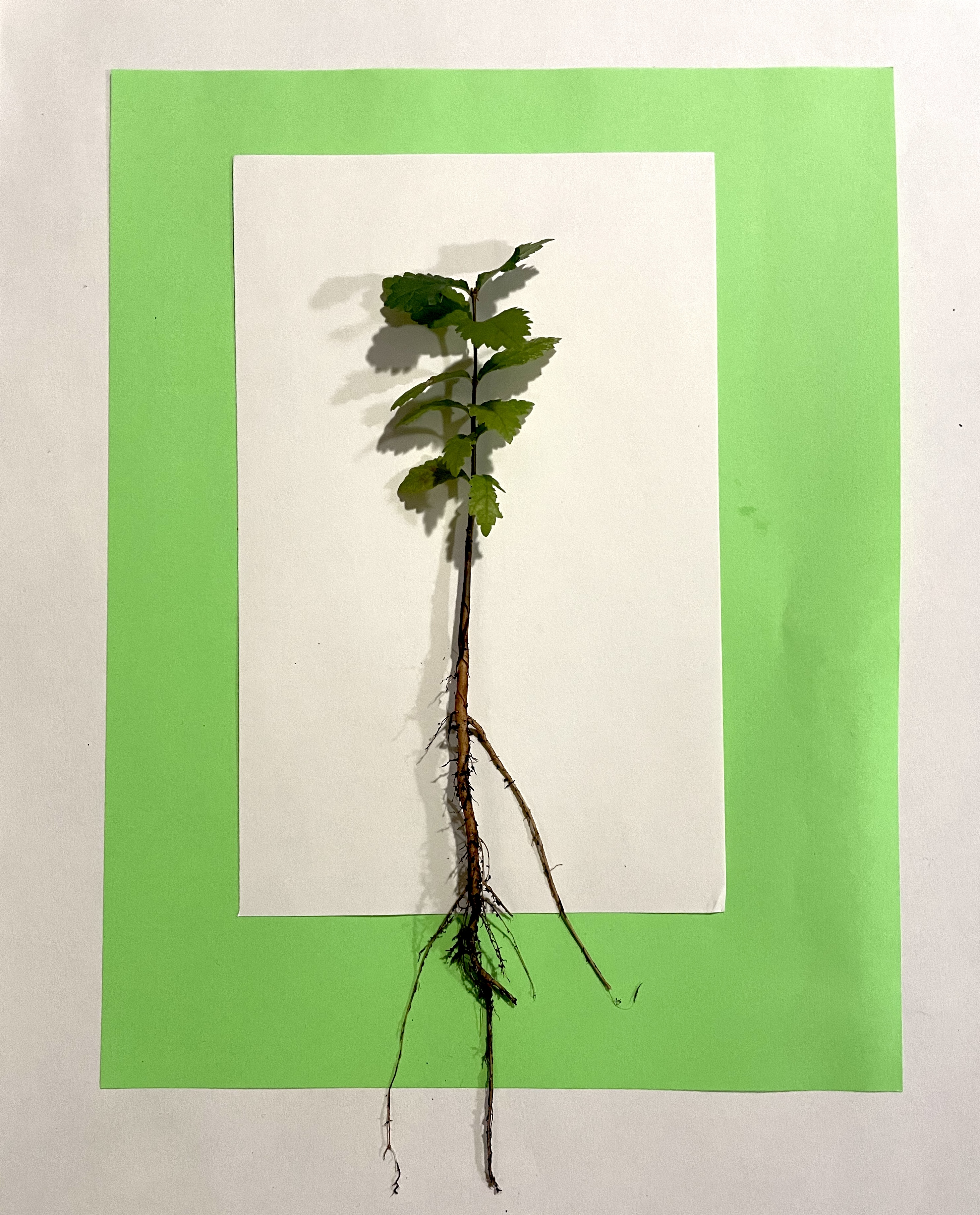
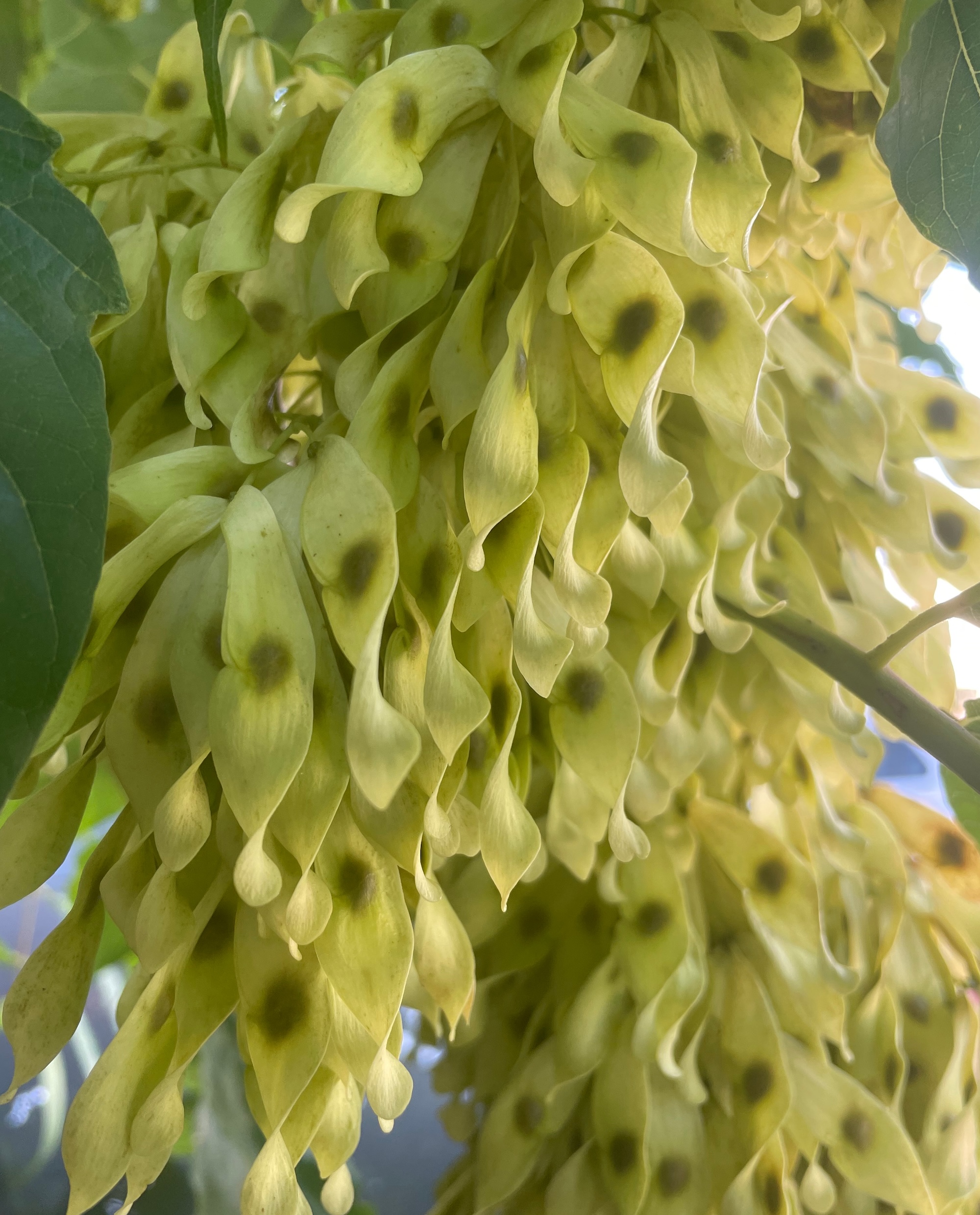
On the left is an example of a native plant of the region – the start of Ulmus americana – American Elm.
On the right are the seed-bearing samaras of one of the most prevelant (noxious) invasives – Ailanthus altissima – commonly known as the Tree of Heaven. It is originally from northeast–central China and Taiwan.
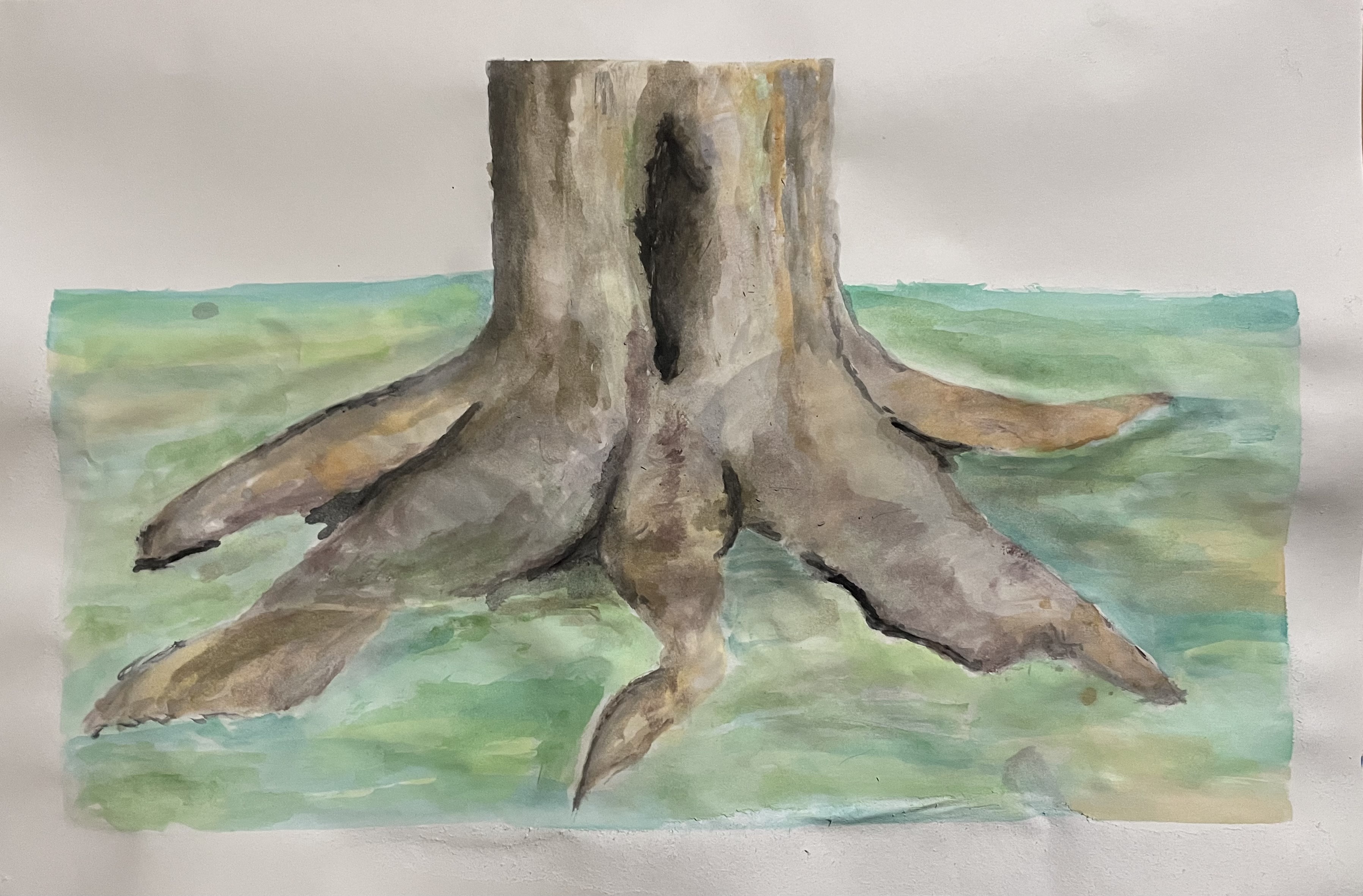
During Arbor Day 2024, together we took a closer look at the ground, and considered the interconnected root systems that trees use to communicate with one another throughout the environment. This work continues through walks, prints, bookmaking, and continued observation and engagement at Warren Park. . . .
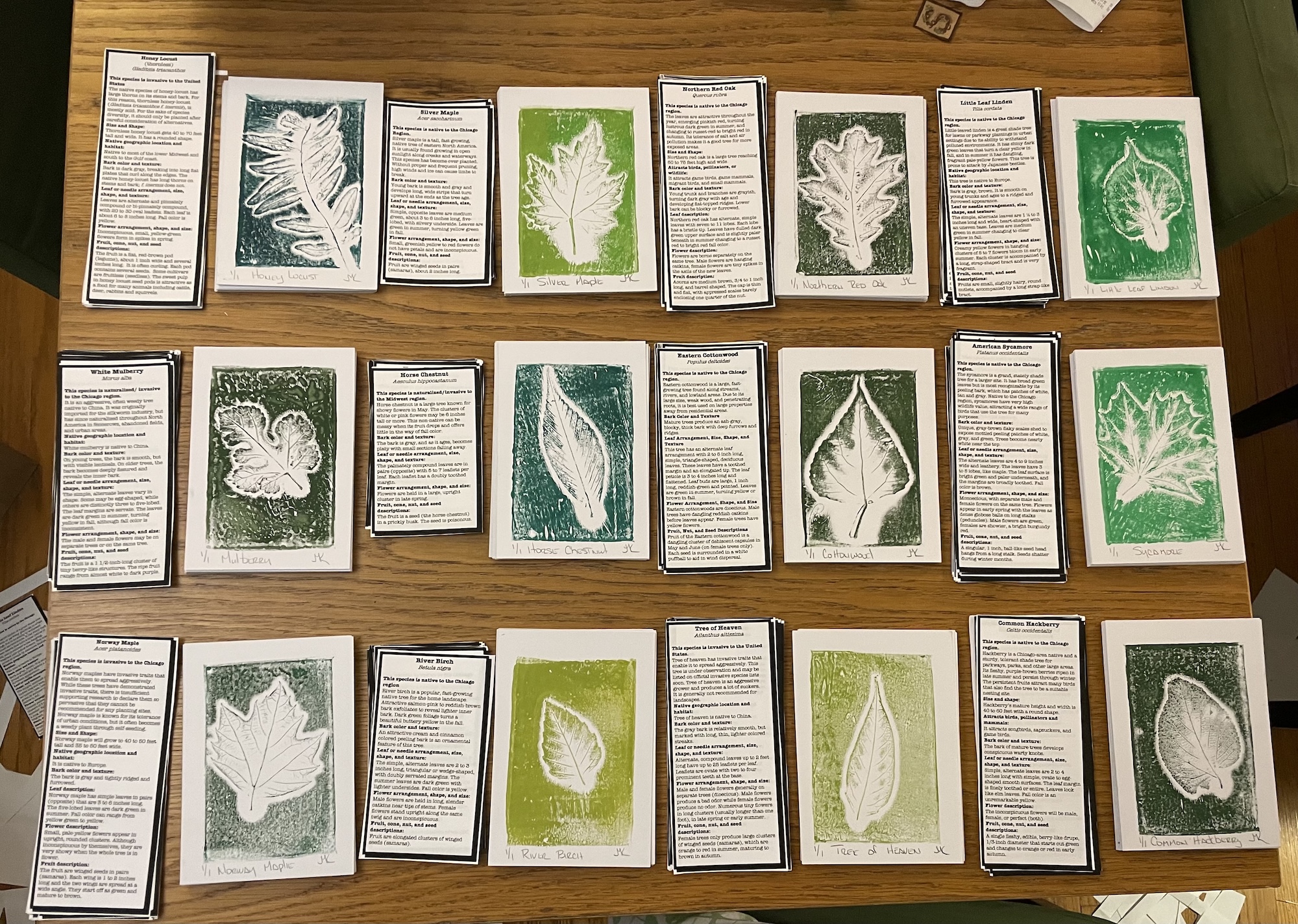
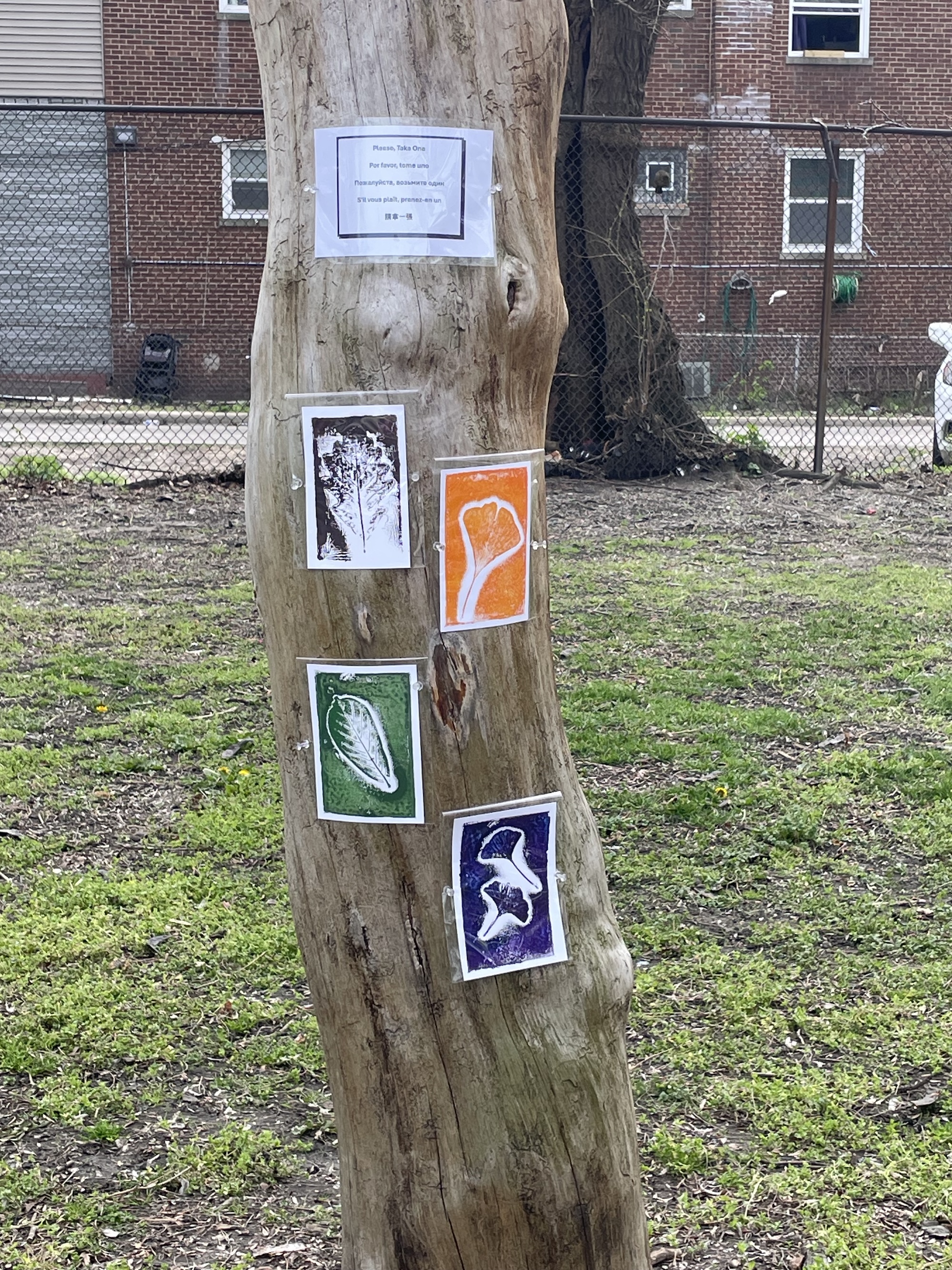
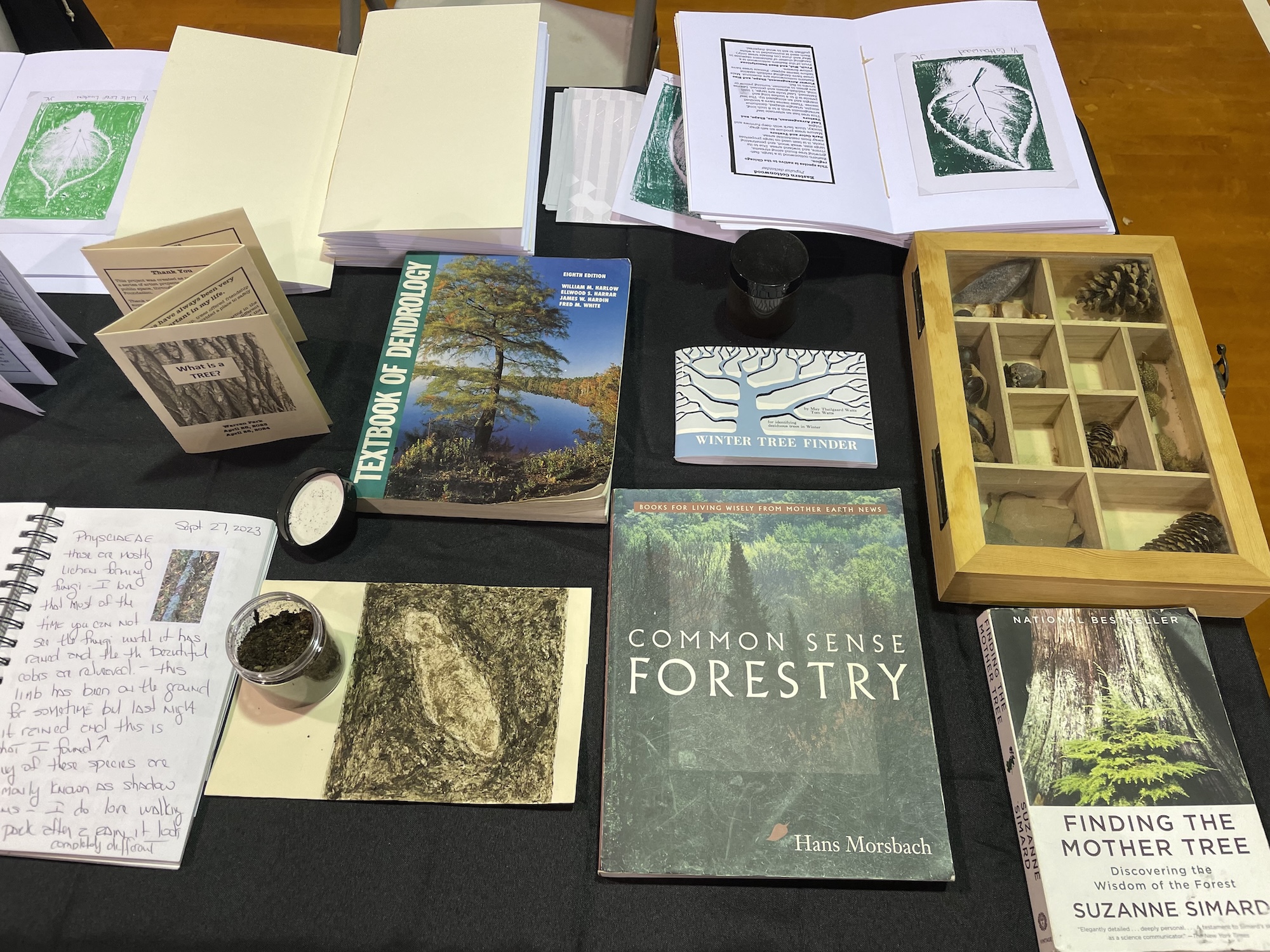
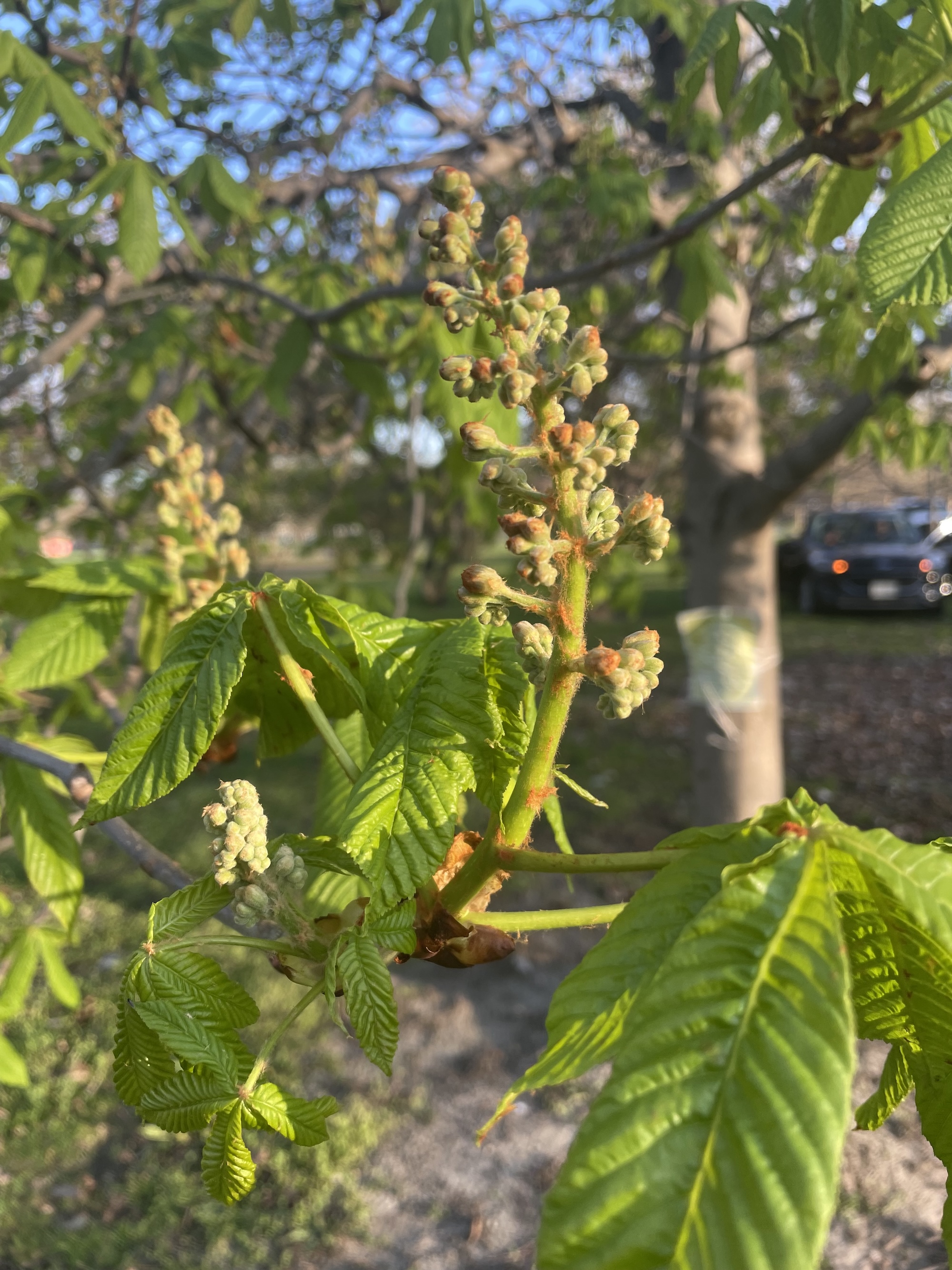




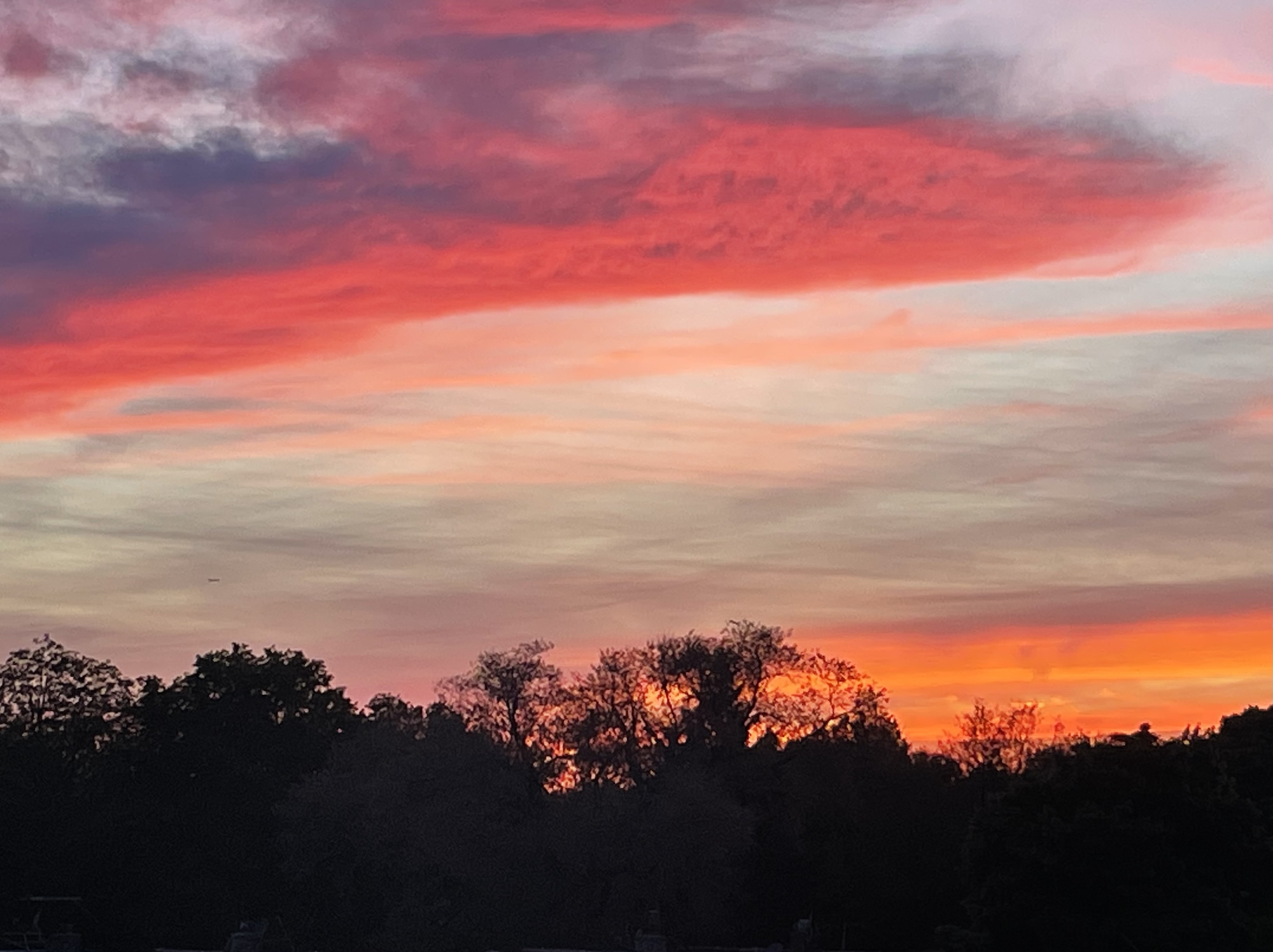






This project is being created as part of Navigations, a series of artist projects in and about public space. In 2025, this project was supported by grants from the Illinois Arts Council Agency; CityArts grants from the City of Chicago Department of Cultural Affairs & Special Events; Cliff Dwellers Arts Foundation; Gaylord and Dorothy Donnelley Foundation; Reva and David Logan Foundation; Teiger Foundation; as well as in-kind support from Chicago Park District. In 2024, this program was supported by Hyde Park Art Center’s Artists Run Chicago Fund in partnership with Art Design Chicago, a citywide collaboration initiated by the Terra Foundation for American Art that highlights the city’s artistic heritage and creative communities. In 2023-24, this program were supported in part by federal assistance listing number 21.027 awarded to Roman Susan Art Foundation NFP by the US Treasury through the American Rescue Plan Coronavirus State and Local Fiscal Recovery Funds in the amount of $50,000, representing 17.5% of total project funding.
Thank you to my partner and unwavering supporter Pablo Escriva, and Katherine Dreher, who instilled within me the concept of ‘The Realm of Possibilities.’ Thank you Warren Park, all the trees and animals that taught me in the silence between the steps of my daily walks about our connection to each other through nature that surrounds us in the city. Appreciation and gratitude to Roman Susan Art Foundation for making What is a Tree? project possible.

John-Michael Korpal creates inter-sensory works exploring the visceral shared space between art and the viewer. Korpal has exhibited throughout the Midwest, with work featured at the Grunwald Gallery of Art at the Kinsey Institute, Governor’s State University, Hyde Park Art Center, and elsewhere. Korpal has completed the Visual Art Certificate Program from Graham School-University of Chicago, and participated in the Center Program at Hyde Park Art Center. Korpal is a member of the Rogers Park Art Alliance, Chicago Calligraphy Collective, West Ridge Artists and Third Estate Art. For more info, please visit johnmichaelkorpal.com.
1-833-NATR-XXX
Toll-free Hotline
1-833-NATR-XXX shares Erotic Experiences with the Natural World for a Person at Home Alone and an expansion of this work for the outdoors in the Rogers Park neighborhood of Chicago, or wherever you dial-in. The hotline houses a series of narrated audio works: Houseplant Intimacy; Fooling Around with Air; For a Person with Running Water; Rock Walk for a Chicago Storefront; Freshwater Beach Walk; Graveyard Meander; and forthcoming creations.
These works are multi-sited and accessible online, as a printed zine, and through the toll-free hotline.
The line is live – call right now: 1-833-NATR-XXX – or scroll below for transcripted experiences.
![]()
Freshwater Beach Walk
Gently enter the beach at the south end.
Look for and find a large weeping willow, poised at the base of an outcropping of land over water.
Get close and put your hand on this tree. Press your palm into the rough grooves of the bark, the skin.
Bring your face very close to your hand until your eyes unfocus and you can’t see the difference between your skin and the skin of the tree.
Your body is pressed to the trunk, your breath is warm on your hand, and your eyeballs are so close that all textures at once obliterate your view.
Now, pull back but continue contact with the tree, in a way that feels good for you. And feels good for the willow.
This is the same kind of tree that was in my grandmother's yard. There was a rope swing on it and we could swing out over the lake and in a moment of bravery, drop into the water. That weedy little lake there was an outlet of this great lake. The pull I feel towards the beach now is an attraction rooted in the intimacy I experienced with freshwater lakes as a child.
What about you?
Do you know freshwater well?
Do you come here often? Are you drawn to the beach like a well known lover or are you afraid of it?
Let’s get closer to the water. We will play a choose your own adventure game.
There are two options to move forward –
through the dunegrass path to the left or down the cement pier on the right. Both paths lead to the same destination.
If you are afraid of the beach, walk down the pier.
If you are turned on by the beach, walk through the dunegrass.
Entering a stretch of dunegrass always makes me think of cruising.
You are cruising in the dunegrass.
A stranger approaches, hard, holes open, wet, ready for you.
The sharp grasses prickle and sting your bare skin as you give in and give out in this semi-secluded public space, quickly and without regret.
Over on the pier, there is stranger danger.
You stand close to the edge, leaning against the thin metal railing to look out over the water, back at the city.
A stranger comes from behind, out of the dunegrass, and for some reason swiftly pushes you over the rail into the waves.
Isn’t it thrilling to splash through the surface, fully clothed and fully soaked.
Heavy and buoyant and sinking and floating.
At the end of both paths, you have reached the shoreline- are you there yet?
You are where the dunegrass sanctuary and the dangerous pier meet the sand meeting the lake.
This lake is massive.
Try as hard as you can to see across it. On the other side, on all of the other sides, there are landscapes mirroring this one.
Just look out. How far can you see?
The seagulls are here. They’re always here. They are the companion of the beach.
While the mallards and the swallows and the geese were away the seagulls have been here all winter with their coats puffed up, gathering on the piers in the dark mornings, in the cold air.
They lean against the wind and are held up by it, they bob and float on the waves.
Scavengers at heart, I can relate to them.
Now they wait for the warm weather, when the beaches fill with bodies and snacks and trash are everywhere.
Do you see that there is an area where many small stones have accumulated on the sand? Swept up into a pile by the currents.
Most of them are orange like tumeric, gray, or white, or black, or sometimes green.
These stones are so smooth, even the ones that are not a smooth shape still have smooth surfaces.
I have a beach date, we meet here and pick up stones to play checkers with on the chess tables nearby. Our teams are usually gray vs. turmeric, oblong ovals. When one player piece is crowned, they turn into another color of stone, and then they have the royal ability to move backwards and forwards and just fuck shit up all over the board. We end up crowned and chasing each other around, square by square, stones sliding on lacquered concrete, stones jumping each other, kicking the other off of the table, back to the beach, back to the crowd. We dance around a conclusion, both angling for a tie. But games aren’t meant to end in ties and I eventually win because there is just so much fire in my chart.
Don’t start looking too closely at the stones, because you will want to take them all home –
you will think you have found a special one, and then another one, and then after a while of being surprised by how many special ones you are finding, you will realize they are all brilliant and you can’t possibly take all of them with you.
There are so so many stones. The Earth keeps giving the stones and the waves keep turning them into sand.
Some people I have met on dating apps have told me that they don’t go to the beach because they don’t like sand.
If you do like sand I want you to touch it.
Sit in the sand. Pick up some loose sand, and as if your hand were a funnel or the waist of an hourglass, release a stream of sand onto the back of your other hand.
Now take another handful and release it on to your palm.
Another, on the back of your hand.
Another, on your forearm, moving down from your elbow to the tip of your middle finger. Now make two fists and extend those middle fingers long and shove them into the sand. Maybe you are deep enough to feel the sand below being a little cooler, maybe moist.
With your fingers buried in the sand and your gaze out at the water, I want you to imagine that the waves are your lover.
They are licking and lapping at you nonstop. Sometimes they slow down, and drag tauntingly down the length of your body.
Sometimes they laugh and lap harder and harder, crashing on your skin, rearranging those molecules like you were the sand.
Close your eyes and listen to the waves. Listen to them touch you.
Stay here like this, and listen.
![]()
Graveyard Meander
Today you are taking yourself on a date, a steamy graveyard date.
Pass through the graveyard gates, crossing the precipice into this delineated Iand, with the familiar textures of stone and grass, soil and text. This is where we visit our dead.
You’re now standing on what is called hallowed ground, a slice of land deemed clean enough for the dead to rest, after a religious ceremony made it sacred and holy.
You are also sacred. But not holy, and not so clean either. You are a little bit naughty for coming in here on this romantic date in this secluded and spooky place.
You slip between rows and rows of phallic protrusions, each one announcing a life lived.
There’s a stillness and a quiet here, it’s palpable. The walls usher a hush, blocking the city sounds. Once you’re in, there are very few ways to get out.
You don’t need to think about how to get out of here though, because I want you to just meander.
Take the path that feels right for your body and move inside it.
This place is reserved for stillness, slowness, no agenda, nowhere to be but here. I hope you wore comfortable clothes and are ready to touch the ground.
Here the trees can spread out and talk to each other without interruption. Here the birds and the deer and the coyotes that somehow live in this city find their privacy. They fuck here. They give birth here. It’s one of the few safe spaces for them to meander and live.
We’ll try not to interrupt them. Or interrupt the mourners, who come here to say goodbye, come back to say hello, bring offerings.
Maybe the graveyard reminds you of a funeral you have been to. I remember the first funeral I went to, I was thirteen, and it was for a friend my age. It was a Christian funeral and I was confused and frustrated by her family’s upbeat attitude, how they kept saying now she is with her savior, so lucky to no longer be with us mortals. I chose to focus on the memory of the two of us smelling sweet dandelions on the playground, laughing at each other’s yellow-tipped noses before burying them deep into the petals again.
Smell is important here. Smell is important to our survival. Your smelliest parts are so very vital.
The olfactory sense is important in knowing what to eat, knowing who to mate with.
Smell is strong here in this memorial space, as odor memories evoke vivid autobiographical experiences. Encounters with smells stay with us and can transport us beyond our bodies.
Do you see a tree? Go over to the tree. Look for a place where a bit of soil is exposed, where the lawn ends at the base of this tree. The soil is the flesh of the earth.
Bend down and with two curled fingers, penetrate the soil and scoop up a cluster into your palm.
Bring the soil close to your face, and inhale the scent deeply. Breathe out through your mouth, onto the soil, warming it, and now bring it even closer to your nose to breathe in again.
Close your eyes and take four deep breaths this way. <audible breathing>
Let the memory that this smell brings open up behind your eyelids, fill your eyeballs, fill your throat. <audible breathing>
Does your family bury the dead? Do they lock them away in caskets or mausoleums, or do they find those coveted spaces where a body can return to the earth wrapped only in fabric? Perhaps they commit the body to flames.
My family cremates our dead and scatters the ashes in Lake Michigan. We go together on a boat to drop them in, taking turns, one handful at a time. The ashes look like glitter when they catch the sun in the water, spread out on bobbing waves before they sink.
All those little pieces of bones, they turn out to be heavy. The rest of the body turned into a cloud that flowed out the furnace chimney, joining the other clouds until it rained.
Now I want you to find a place to lay down. Lay down flat.
How many bodies have been laid to rest here, resting, resting, in their final resting place.
But how can we really rest when we live on in memories and stories and the advice we gave and fights we had. Have you ever talked to someone for the last time? Did they say something that made you never want to talk to them again? They go on living but for you they ended with that conversation, they live on in that conversation, they don’t get the chance to fill in more space in your mind or your life. They haunt you. You haunt them.
You are already haunting people and you haven’t even died yet.
Life is a series of impermanences. Think about all the things you like about your body. All those hot spots and good crevices and protrusions. They won't be around forever, so you should enjoy them now. Maybe right now.
Sink a little deeper into the earth you are laying on. Not far below the barrier of clothing and grass is the mycelial network, pulsing through the soil with earthy electric currents. It’s a massive network of cellular strands, thin like threads, reaching to join each other with intertwined tips and connect all the roots of all the plants.
This quiet and slow place is ideal for mushrooms, who are quiet and slow, to fruit from their mycelium roots. Mushrooms are organs of sexual reproduction, just as you are and I am.
Fungi reject the binary of plants and animals, mixing qualities of both in their queer existence.
They rely on mutualism and hold no hierarchies. If only we could be like mushrooms.
Humans are temporary fruits that come above ground and drop our spores, and decompose everything in our path, and feed the network of the bodies buried below. We pop up after a rain and show our colors. We are dirty, we are filthy, we don’t fit the standard of classification. Decomposition is very steamy, very hot. And very very smelly. It transforms and consumes and peels away everything that isn’t nutritious.
It’s hard to think past the scale we exist in, the scale of the human lifespan. Mycelium is the oldest living organism, it has outlived millions of other species on this planet and it can live forever and it knows all of your secrets. If anything, this network of fine strands could take some of those secrets, some of your dirt, some of your filth, and metabolize it for you.
It could connect you, to other mushrooms, plants, ashes, bones.
Now I want you to squeeze every muscle in your body, become hard. Harder. Harder.
That’s really hard.
Now relax, relax your pelvis, relax your fingertips, relax your forehead, relax yourself into the ground, dropping your spores, through your open palms, into hallow hollow ground.
![]()
A rock walk for someone at a Chicago storefront
Rocks are all around us, ever changing, made by earth ingredients that shift and squish and heat and cool and meld to one another.
Rocks squeeze out of the crust, they join bodies with other rocks. They fall apart and they build back up again with new mineral compositions, new geographies, as they build geologies.
Here in the city, rocks have been transformed into new rock – the cement and asphalt and brick that covers the ground and rises from it in squares and rectangles. These are rocks displaced by human hands, by machines, by transport. They are mined and blasted and crushed and churned and fired until they take the new shape that we like.
Now I'm going to take you on a rock walk.
You are standing in front of a storefront window.
Turn around and walk across the street. Here is a gravel lot behind a chain link fence. You can see the debris of construction – loose piles and neat stacks of man-made rocks.
Look down at the borderline between the public sidewalk and this private lot and you will find many stones.
A stone is what we call a smaller piece of rock. A stone you can carry.
Get closer to these stones and choose one to take with you on this walk.
Many of these are sedimentary rocks- a stone made of other stones.
Can you look close and see the makeup of your stone?
What are its qualities? What is its smell?
This one looks like it might be concrete, globbing together peach-colored gravel. This one is grey with greenish chunks that flake when scraped.
This one is dark and smooth, round on one end and flat on the other.
Is your stone wet? Get it wet. Put a little bit of your spit on it, and see, how does it change? Do you dare give it a lick?
Once you have chosen your stone, wrap it tightly with your fingers, against your your palm, the warmth of your blood pulsing below the surface will gradually change the temperature of this stone, now set adrift by your body.
Cross the street again, back to the storefront, squeezing your stone.
Do you know what makes a rock hard? It's pressure.
Pressure makes me hard too. And friction.
What makes you hard?
Rocks are all about pressure, and texture, and weather.
Rocks teach us about transformation and adaptation.
Changes, both sudden and gradual, usher geologic formation.
Now look at the decorative details of the storefront.
This column is covered in spiraling nipples! Stroke them gently with your fingertips. Press a cheek to them, explore the hardness against your soft skin. What stone is this? Were these protrusions carved out of sandstone? Or were they cast with a slurried mix of mined limestone and shale? Were rough-hewn blocks of stone excavated nearby, or did they travel far to make this building?
Follow the building’s facade around the corner and now you are in an alleyway, flanked by a stretch of brick buildings conjured in clay on one side, and a cement wall speckled with pebbles that supports the train line on the other. Inspect this cement wall, see what stones are temporarily lodged there, what rock formations have accumulated on the ground. Perhaps touch these stones with the one that you are carrying.
Two blocks east of here, there is a beach full of stones.
The water is lapping at them right now, stirring and grinding them.
With every wave they become more round, more smooth.
Some of the stones you might find on this beach are actually brick, are actually asphalt disguised as pudding stones.
The man-made stones find their way back into the rock cycle, back into the earth and the sand and the wind. The tiniest bits of rock traveling through this alley in rainy runoff and dusty gusts will eventually compress again, amassing together into a strong, hard, archive of experiences.
With your rock in hand, start walking down this alley.
Just as the train slides by, moving static bodies along the line, the rocks surrounding you have been moved and relocated infinite times.
Water has done most of this work.
Freezing erosion, glacial drag, rushing rivers.
Close your eyes, keep walking. Pretend now that you are water, flowing down this ravine, carrying the stone down yet another path to transformation.
Yes, keep your eyes closed, walk in a straight line and this alleyway will hold you. The stones below are holding you.
Open your eyes, rock is all around you.
Keep walking forward, towards the split in your path.
Your stopping point is ahead, where this alleyway becomes two.
How can we embody a stone? I’ve been stone cold, I’ve been stoned out of my mind, I’ve been a rolling stone, transient and light and unattached.
Metamorphic rocks start as one type of rock and gradually change into a new type. They become stronger and denser under pressure. Perhaps like a stone I have congealed as a conglomerate and become more myself.
Now I am in another process of becoming lighter. I had a car for 10 years and I recently decided to sell it. As I started to dig out the layers of trash and memories, I realized that my car was full of stones. A handful of them from a month spent in Utah, others from countless trips to Lake Michigan beaches. Each one a souvenir. Even Canadian coins I flattened on New England train tracks, these are a touchstone for an experience, a chunk of mineral I picked up while rolling along.
Stones often hold the energy of a place, and we also put our own memories on them – is this another meaning for the phrase “to set in stone”?
Have you reached the fork in the road? This is the end of our walk. Find a place to set your stone down here. Now, find a different stone to pick up, it could very well have been left here by another rock walker, a snow plow, or a sudden downpour. Give your new stone a sniff, maybe a lick. Turn it around and around in your fingers, then tuck it into your pocket to take it away.
Keep this stone on you, as a talisman for now, ascribe it with your own meaning, and when the time is right drop it off at another geological site.
![]()
Since 2020, 1-833-NATR-XXX has been distributed in public through posters and tagging in cities across the U.S. and Canada. Fernand has developed "commercials" for the hotline, riffing on promotions for anti-depressants, phone sex lines, and miracle products.
New elements are being added to the hotline as a part of Navigations, a series of artist projects in and about public space. In 2025, this project was supported by grants from the Illinois Arts Council Agency; CityArts grants from the City of Chicago Department of Cultural Affairs & Special Events; Cliff Dwellers Arts Foundation; Gaylord and Dorothy Donnelley Foundation; Reva and David Logan Foundation; Teiger Foundation; as well as in-kind support from Chicago Park District. In 2024, this program was supported by Hyde Park Art Center’s Artists Run Chicago Fund in partnership with Art Design Chicago, a citywide collaboration initiated by the Terra Foundation for American Art that highlights the city’s artistic heritage and creative communities. In 2023-24, this program were supported in part by federal assistance listing number 21.027 awarded to Roman Susan Art Foundation NFP by the US Treasury through the American Rescue Plan Coronavirus State and Local Fiscal Recovery Funds in the amount of $50,000, representing 17.5% of total project funding.
Eliza Fernand is an artist and educator who works primarily with video, sound, fabric, and clay. With a BFA in Sculpture from Pacific Northwest College of Art, and an MFA in Interdisciplinary Arts from Sierra Nevada University, they have led a cross-country career, attending over a dozen artist residencies and exhibiting internationally. A new citizen of Chicago, she continues to pursue artmaking and teaching opportunities, with the aim of provoking acceptance of loving practices outside of the norm, and promoting experimentation on all levels. For more information, please visit elizafernand.com.
Graveyard Meander (PDF)
Freshwater Beach Walk (PDF)
A rock walk for someone at a Chicago storefront (PDF)
Eliza Fernand “NATR-XXX” at Roman Susan | Chicago Artist Writers - March 14, 2023
The line is live – call right now: 1-833-NATR-XXX – or scroll below for transcripted experiences.

Freshwater Beach Walk
Gently enter the beach at the south end.
Look for and find a large weeping willow, poised at the base of an outcropping of land over water.
Get close and put your hand on this tree. Press your palm into the rough grooves of the bark, the skin.
Bring your face very close to your hand until your eyes unfocus and you can’t see the difference between your skin and the skin of the tree.
Your body is pressed to the trunk, your breath is warm on your hand, and your eyeballs are so close that all textures at once obliterate your view.
Now, pull back but continue contact with the tree, in a way that feels good for you. And feels good for the willow.
This is the same kind of tree that was in my grandmother's yard. There was a rope swing on it and we could swing out over the lake and in a moment of bravery, drop into the water. That weedy little lake there was an outlet of this great lake. The pull I feel towards the beach now is an attraction rooted in the intimacy I experienced with freshwater lakes as a child.
What about you?
Do you know freshwater well?
Do you come here often? Are you drawn to the beach like a well known lover or are you afraid of it?
Let’s get closer to the water. We will play a choose your own adventure game.
There are two options to move forward –
through the dunegrass path to the left or down the cement pier on the right. Both paths lead to the same destination.
If you are afraid of the beach, walk down the pier.
If you are turned on by the beach, walk through the dunegrass.
Entering a stretch of dunegrass always makes me think of cruising.
You are cruising in the dunegrass.
A stranger approaches, hard, holes open, wet, ready for you.
The sharp grasses prickle and sting your bare skin as you give in and give out in this semi-secluded public space, quickly and without regret.
Over on the pier, there is stranger danger.
You stand close to the edge, leaning against the thin metal railing to look out over the water, back at the city.
A stranger comes from behind, out of the dunegrass, and for some reason swiftly pushes you over the rail into the waves.
Isn’t it thrilling to splash through the surface, fully clothed and fully soaked.
Heavy and buoyant and sinking and floating.
At the end of both paths, you have reached the shoreline- are you there yet?
You are where the dunegrass sanctuary and the dangerous pier meet the sand meeting the lake.
This lake is massive.
Try as hard as you can to see across it. On the other side, on all of the other sides, there are landscapes mirroring this one.
Just look out. How far can you see?
The seagulls are here. They’re always here. They are the companion of the beach.
While the mallards and the swallows and the geese were away the seagulls have been here all winter with their coats puffed up, gathering on the piers in the dark mornings, in the cold air.
They lean against the wind and are held up by it, they bob and float on the waves.
Scavengers at heart, I can relate to them.
Now they wait for the warm weather, when the beaches fill with bodies and snacks and trash are everywhere.
Do you see that there is an area where many small stones have accumulated on the sand? Swept up into a pile by the currents.
Most of them are orange like tumeric, gray, or white, or black, or sometimes green.
These stones are so smooth, even the ones that are not a smooth shape still have smooth surfaces.
I have a beach date, we meet here and pick up stones to play checkers with on the chess tables nearby. Our teams are usually gray vs. turmeric, oblong ovals. When one player piece is crowned, they turn into another color of stone, and then they have the royal ability to move backwards and forwards and just fuck shit up all over the board. We end up crowned and chasing each other around, square by square, stones sliding on lacquered concrete, stones jumping each other, kicking the other off of the table, back to the beach, back to the crowd. We dance around a conclusion, both angling for a tie. But games aren’t meant to end in ties and I eventually win because there is just so much fire in my chart.
Don’t start looking too closely at the stones, because you will want to take them all home –
you will think you have found a special one, and then another one, and then after a while of being surprised by how many special ones you are finding, you will realize they are all brilliant and you can’t possibly take all of them with you.
There are so so many stones. The Earth keeps giving the stones and the waves keep turning them into sand.
Some people I have met on dating apps have told me that they don’t go to the beach because they don’t like sand.
If you do like sand I want you to touch it.
Sit in the sand. Pick up some loose sand, and as if your hand were a funnel or the waist of an hourglass, release a stream of sand onto the back of your other hand.
Now take another handful and release it on to your palm.
Another, on the back of your hand.
Another, on your forearm, moving down from your elbow to the tip of your middle finger. Now make two fists and extend those middle fingers long and shove them into the sand. Maybe you are deep enough to feel the sand below being a little cooler, maybe moist.
With your fingers buried in the sand and your gaze out at the water, I want you to imagine that the waves are your lover.
They are licking and lapping at you nonstop. Sometimes they slow down, and drag tauntingly down the length of your body.
Sometimes they laugh and lap harder and harder, crashing on your skin, rearranging those molecules like you were the sand.
Close your eyes and listen to the waves. Listen to them touch you.
Stay here like this, and listen.
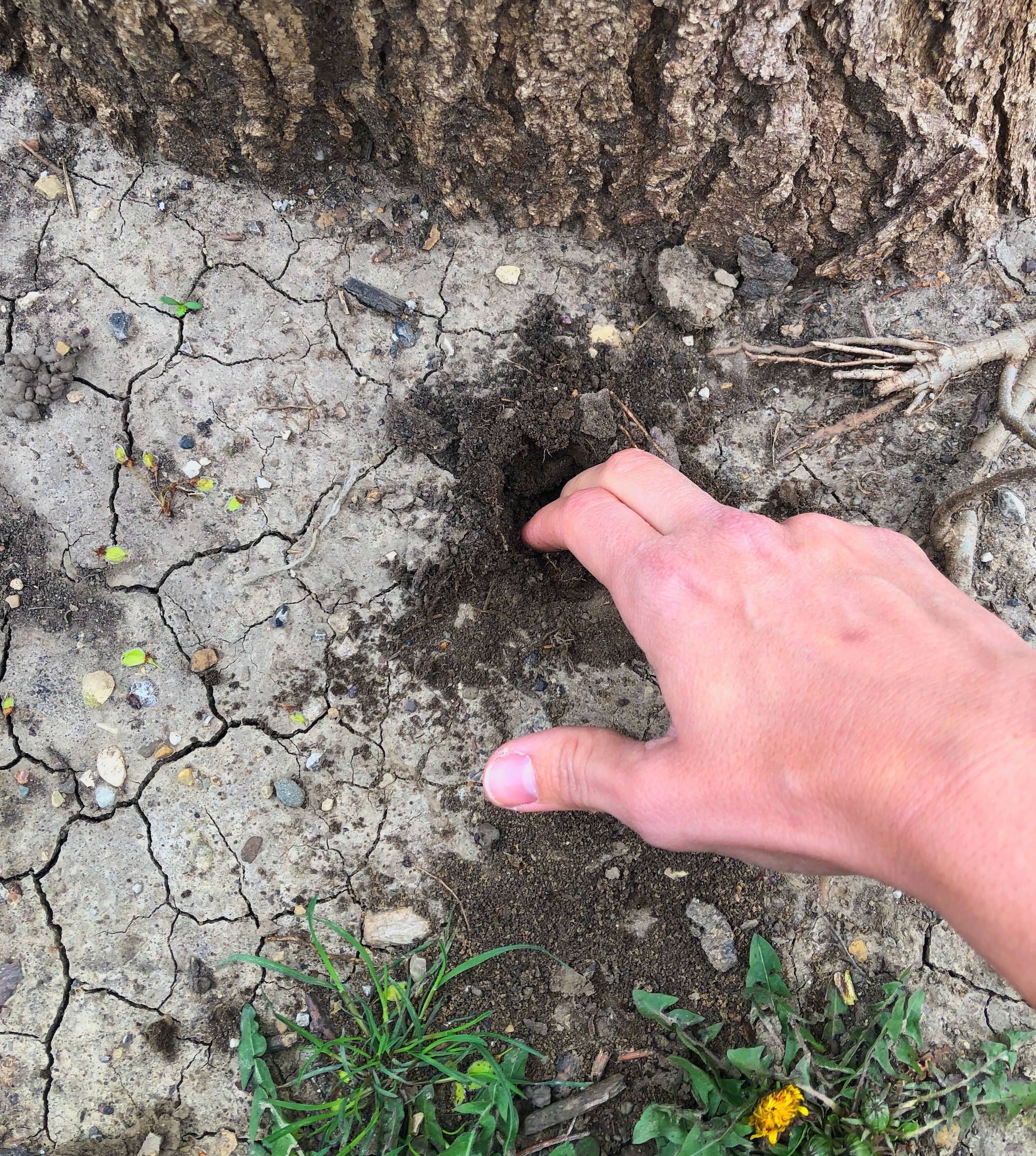
Graveyard Meander
Today you are taking yourself on a date, a steamy graveyard date.
Pass through the graveyard gates, crossing the precipice into this delineated Iand, with the familiar textures of stone and grass, soil and text. This is where we visit our dead.
You’re now standing on what is called hallowed ground, a slice of land deemed clean enough for the dead to rest, after a religious ceremony made it sacred and holy.
You are also sacred. But not holy, and not so clean either. You are a little bit naughty for coming in here on this romantic date in this secluded and spooky place.
You slip between rows and rows of phallic protrusions, each one announcing a life lived.
There’s a stillness and a quiet here, it’s palpable. The walls usher a hush, blocking the city sounds. Once you’re in, there are very few ways to get out.
You don’t need to think about how to get out of here though, because I want you to just meander.
Take the path that feels right for your body and move inside it.
This place is reserved for stillness, slowness, no agenda, nowhere to be but here. I hope you wore comfortable clothes and are ready to touch the ground.
Here the trees can spread out and talk to each other without interruption. Here the birds and the deer and the coyotes that somehow live in this city find their privacy. They fuck here. They give birth here. It’s one of the few safe spaces for them to meander and live.
We’ll try not to interrupt them. Or interrupt the mourners, who come here to say goodbye, come back to say hello, bring offerings.
Maybe the graveyard reminds you of a funeral you have been to. I remember the first funeral I went to, I was thirteen, and it was for a friend my age. It was a Christian funeral and I was confused and frustrated by her family’s upbeat attitude, how they kept saying now she is with her savior, so lucky to no longer be with us mortals. I chose to focus on the memory of the two of us smelling sweet dandelions on the playground, laughing at each other’s yellow-tipped noses before burying them deep into the petals again.
Smell is important here. Smell is important to our survival. Your smelliest parts are so very vital.
The olfactory sense is important in knowing what to eat, knowing who to mate with.
Smell is strong here in this memorial space, as odor memories evoke vivid autobiographical experiences. Encounters with smells stay with us and can transport us beyond our bodies.
Do you see a tree? Go over to the tree. Look for a place where a bit of soil is exposed, where the lawn ends at the base of this tree. The soil is the flesh of the earth.
Bend down and with two curled fingers, penetrate the soil and scoop up a cluster into your palm.
Bring the soil close to your face, and inhale the scent deeply. Breathe out through your mouth, onto the soil, warming it, and now bring it even closer to your nose to breathe in again.
Close your eyes and take four deep breaths this way. <audible breathing>
Let the memory that this smell brings open up behind your eyelids, fill your eyeballs, fill your throat. <audible breathing>
Does your family bury the dead? Do they lock them away in caskets or mausoleums, or do they find those coveted spaces where a body can return to the earth wrapped only in fabric? Perhaps they commit the body to flames.
My family cremates our dead and scatters the ashes in Lake Michigan. We go together on a boat to drop them in, taking turns, one handful at a time. The ashes look like glitter when they catch the sun in the water, spread out on bobbing waves before they sink.
All those little pieces of bones, they turn out to be heavy. The rest of the body turned into a cloud that flowed out the furnace chimney, joining the other clouds until it rained.
Now I want you to find a place to lay down. Lay down flat.
How many bodies have been laid to rest here, resting, resting, in their final resting place.
But how can we really rest when we live on in memories and stories and the advice we gave and fights we had. Have you ever talked to someone for the last time? Did they say something that made you never want to talk to them again? They go on living but for you they ended with that conversation, they live on in that conversation, they don’t get the chance to fill in more space in your mind or your life. They haunt you. You haunt them.
You are already haunting people and you haven’t even died yet.
Life is a series of impermanences. Think about all the things you like about your body. All those hot spots and good crevices and protrusions. They won't be around forever, so you should enjoy them now. Maybe right now.
Sink a little deeper into the earth you are laying on. Not far below the barrier of clothing and grass is the mycelial network, pulsing through the soil with earthy electric currents. It’s a massive network of cellular strands, thin like threads, reaching to join each other with intertwined tips and connect all the roots of all the plants.
This quiet and slow place is ideal for mushrooms, who are quiet and slow, to fruit from their mycelium roots. Mushrooms are organs of sexual reproduction, just as you are and I am.
Fungi reject the binary of plants and animals, mixing qualities of both in their queer existence.
They rely on mutualism and hold no hierarchies. If only we could be like mushrooms.
Humans are temporary fruits that come above ground and drop our spores, and decompose everything in our path, and feed the network of the bodies buried below. We pop up after a rain and show our colors. We are dirty, we are filthy, we don’t fit the standard of classification. Decomposition is very steamy, very hot. And very very smelly. It transforms and consumes and peels away everything that isn’t nutritious.
It’s hard to think past the scale we exist in, the scale of the human lifespan. Mycelium is the oldest living organism, it has outlived millions of other species on this planet and it can live forever and it knows all of your secrets. If anything, this network of fine strands could take some of those secrets, some of your dirt, some of your filth, and metabolize it for you.
It could connect you, to other mushrooms, plants, ashes, bones.
Now I want you to squeeze every muscle in your body, become hard. Harder. Harder.
That’s really hard.
Now relax, relax your pelvis, relax your fingertips, relax your forehead, relax yourself into the ground, dropping your spores, through your open palms, into hallow hollow ground.
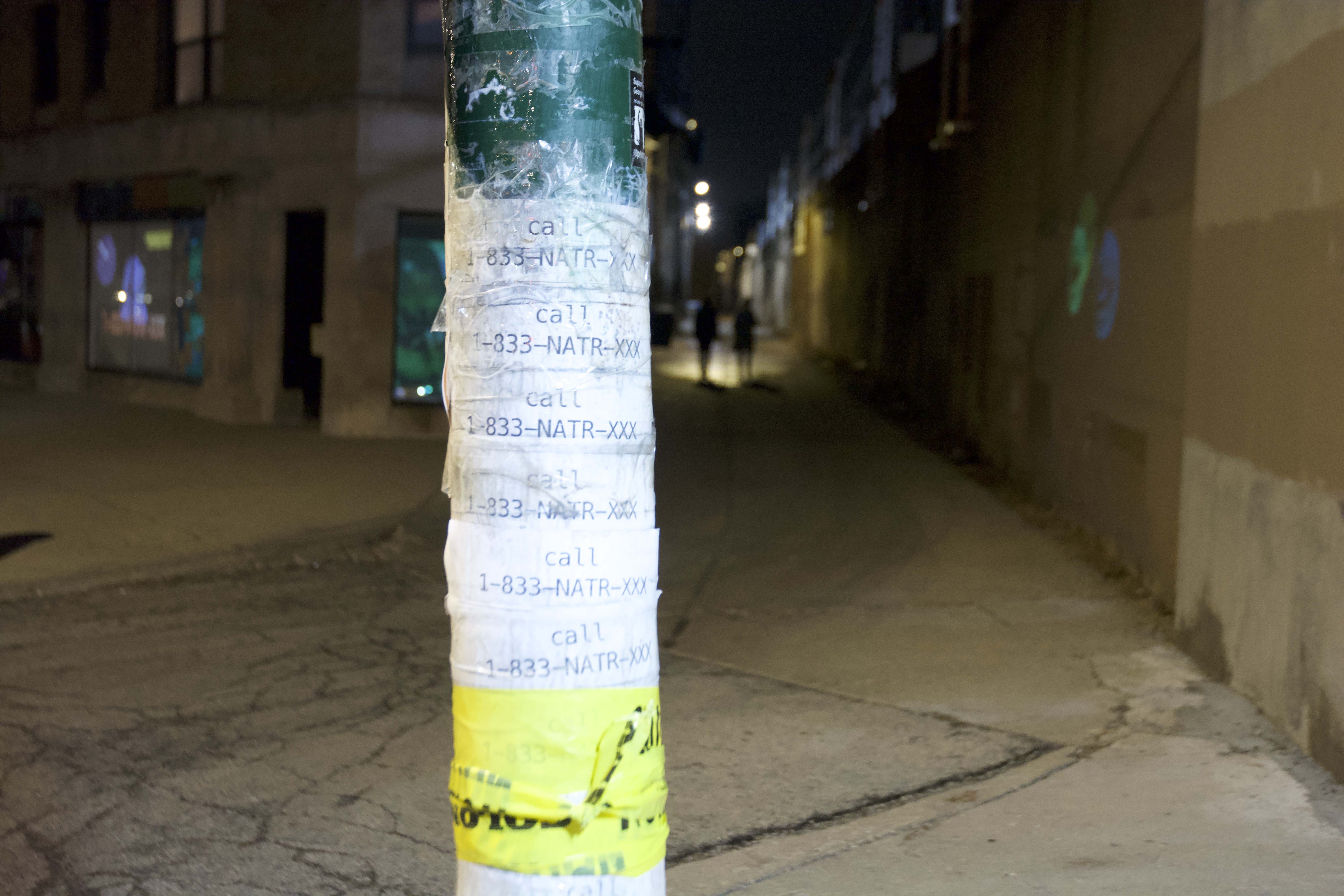
A rock walk for someone at a Chicago storefront
Rocks are all around us, ever changing, made by earth ingredients that shift and squish and heat and cool and meld to one another.
Rocks squeeze out of the crust, they join bodies with other rocks. They fall apart and they build back up again with new mineral compositions, new geographies, as they build geologies.
Here in the city, rocks have been transformed into new rock – the cement and asphalt and brick that covers the ground and rises from it in squares and rectangles. These are rocks displaced by human hands, by machines, by transport. They are mined and blasted and crushed and churned and fired until they take the new shape that we like.
Now I'm going to take you on a rock walk.
You are standing in front of a storefront window.
Turn around and walk across the street. Here is a gravel lot behind a chain link fence. You can see the debris of construction – loose piles and neat stacks of man-made rocks.
Look down at the borderline between the public sidewalk and this private lot and you will find many stones.
A stone is what we call a smaller piece of rock. A stone you can carry.
Get closer to these stones and choose one to take with you on this walk.
Many of these are sedimentary rocks- a stone made of other stones.
Can you look close and see the makeup of your stone?
What are its qualities? What is its smell?
This one looks like it might be concrete, globbing together peach-colored gravel. This one is grey with greenish chunks that flake when scraped.
This one is dark and smooth, round on one end and flat on the other.
Is your stone wet? Get it wet. Put a little bit of your spit on it, and see, how does it change? Do you dare give it a lick?
Once you have chosen your stone, wrap it tightly with your fingers, against your your palm, the warmth of your blood pulsing below the surface will gradually change the temperature of this stone, now set adrift by your body.
Cross the street again, back to the storefront, squeezing your stone.
Do you know what makes a rock hard? It's pressure.
Pressure makes me hard too. And friction.
What makes you hard?
Rocks are all about pressure, and texture, and weather.
Rocks teach us about transformation and adaptation.
Changes, both sudden and gradual, usher geologic formation.
Now look at the decorative details of the storefront.
This column is covered in spiraling nipples! Stroke them gently with your fingertips. Press a cheek to them, explore the hardness against your soft skin. What stone is this? Were these protrusions carved out of sandstone? Or were they cast with a slurried mix of mined limestone and shale? Were rough-hewn blocks of stone excavated nearby, or did they travel far to make this building?
Follow the building’s facade around the corner and now you are in an alleyway, flanked by a stretch of brick buildings conjured in clay on one side, and a cement wall speckled with pebbles that supports the train line on the other. Inspect this cement wall, see what stones are temporarily lodged there, what rock formations have accumulated on the ground. Perhaps touch these stones with the one that you are carrying.
Two blocks east of here, there is a beach full of stones.
The water is lapping at them right now, stirring and grinding them.
With every wave they become more round, more smooth.
Some of the stones you might find on this beach are actually brick, are actually asphalt disguised as pudding stones.
The man-made stones find their way back into the rock cycle, back into the earth and the sand and the wind. The tiniest bits of rock traveling through this alley in rainy runoff and dusty gusts will eventually compress again, amassing together into a strong, hard, archive of experiences.
With your rock in hand, start walking down this alley.
Just as the train slides by, moving static bodies along the line, the rocks surrounding you have been moved and relocated infinite times.
Water has done most of this work.
Freezing erosion, glacial drag, rushing rivers.
Close your eyes, keep walking. Pretend now that you are water, flowing down this ravine, carrying the stone down yet another path to transformation.
Yes, keep your eyes closed, walk in a straight line and this alleyway will hold you. The stones below are holding you.
Open your eyes, rock is all around you.
Keep walking forward, towards the split in your path.
Your stopping point is ahead, where this alleyway becomes two.
How can we embody a stone? I’ve been stone cold, I’ve been stoned out of my mind, I’ve been a rolling stone, transient and light and unattached.
Metamorphic rocks start as one type of rock and gradually change into a new type. They become stronger and denser under pressure. Perhaps like a stone I have congealed as a conglomerate and become more myself.
Now I am in another process of becoming lighter. I had a car for 10 years and I recently decided to sell it. As I started to dig out the layers of trash and memories, I realized that my car was full of stones. A handful of them from a month spent in Utah, others from countless trips to Lake Michigan beaches. Each one a souvenir. Even Canadian coins I flattened on New England train tracks, these are a touchstone for an experience, a chunk of mineral I picked up while rolling along.
Stones often hold the energy of a place, and we also put our own memories on them – is this another meaning for the phrase “to set in stone”?
Have you reached the fork in the road? This is the end of our walk. Find a place to set your stone down here. Now, find a different stone to pick up, it could very well have been left here by another rock walker, a snow plow, or a sudden downpour. Give your new stone a sniff, maybe a lick. Turn it around and around in your fingers, then tuck it into your pocket to take it away.
Keep this stone on you, as a talisman for now, ascribe it with your own meaning, and when the time is right drop it off at another geological site.
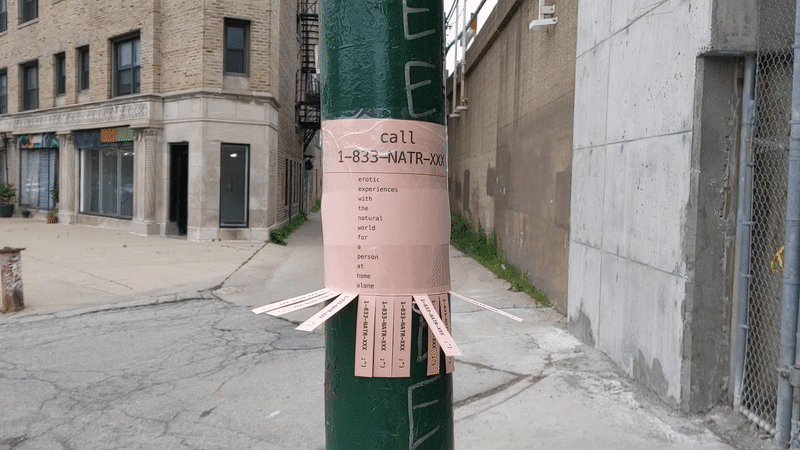
Since 2020, 1-833-NATR-XXX has been distributed in public through posters and tagging in cities across the U.S. and Canada. Fernand has developed "commercials" for the hotline, riffing on promotions for anti-depressants, phone sex lines, and miracle products.
New elements are being added to the hotline as a part of Navigations, a series of artist projects in and about public space. In 2025, this project was supported by grants from the Illinois Arts Council Agency; CityArts grants from the City of Chicago Department of Cultural Affairs & Special Events; Cliff Dwellers Arts Foundation; Gaylord and Dorothy Donnelley Foundation; Reva and David Logan Foundation; Teiger Foundation; as well as in-kind support from Chicago Park District. In 2024, this program was supported by Hyde Park Art Center’s Artists Run Chicago Fund in partnership with Art Design Chicago, a citywide collaboration initiated by the Terra Foundation for American Art that highlights the city’s artistic heritage and creative communities. In 2023-24, this program were supported in part by federal assistance listing number 21.027 awarded to Roman Susan Art Foundation NFP by the US Treasury through the American Rescue Plan Coronavirus State and Local Fiscal Recovery Funds in the amount of $50,000, representing 17.5% of total project funding.
Eliza Fernand is an artist and educator who works primarily with video, sound, fabric, and clay. With a BFA in Sculpture from Pacific Northwest College of Art, and an MFA in Interdisciplinary Arts from Sierra Nevada University, they have led a cross-country career, attending over a dozen artist residencies and exhibiting internationally. A new citizen of Chicago, she continues to pursue artmaking and teaching opportunities, with the aim of provoking acceptance of loving practices outside of the norm, and promoting experimentation on all levels. For more information, please visit elizafernand.com.
Graveyard Meander (PDF)
Freshwater Beach Walk (PDF)
A rock walk for someone at a Chicago storefront (PDF)
Eliza Fernand “NATR-XXX” at Roman Susan | Chicago Artist Writers - March 14, 2023
Shore Land
Lakefill into ᒥᓯᑲᒥ

Berger Park // Belmont Harbor // Grant Park // 31st Street Beach // Jackson Park // Calumet Park
For full project materials for all sites, please visit jeeyeunlee.com/shore-land.
From the first years of white settlement in Chicago, the Lake Michigan shore has been intensely engineered. Over the years, land has been constructed along the lake from trash, rubble of the Chicago Fire, dirt dug up from highway construction elsewhere in the city, and sand from the Indiana Dunes and the bottom of Lake Michigan. Now, more than 5.5 square miles of lakefill stretch across 30 miles of shore from Evanston to Indiana.
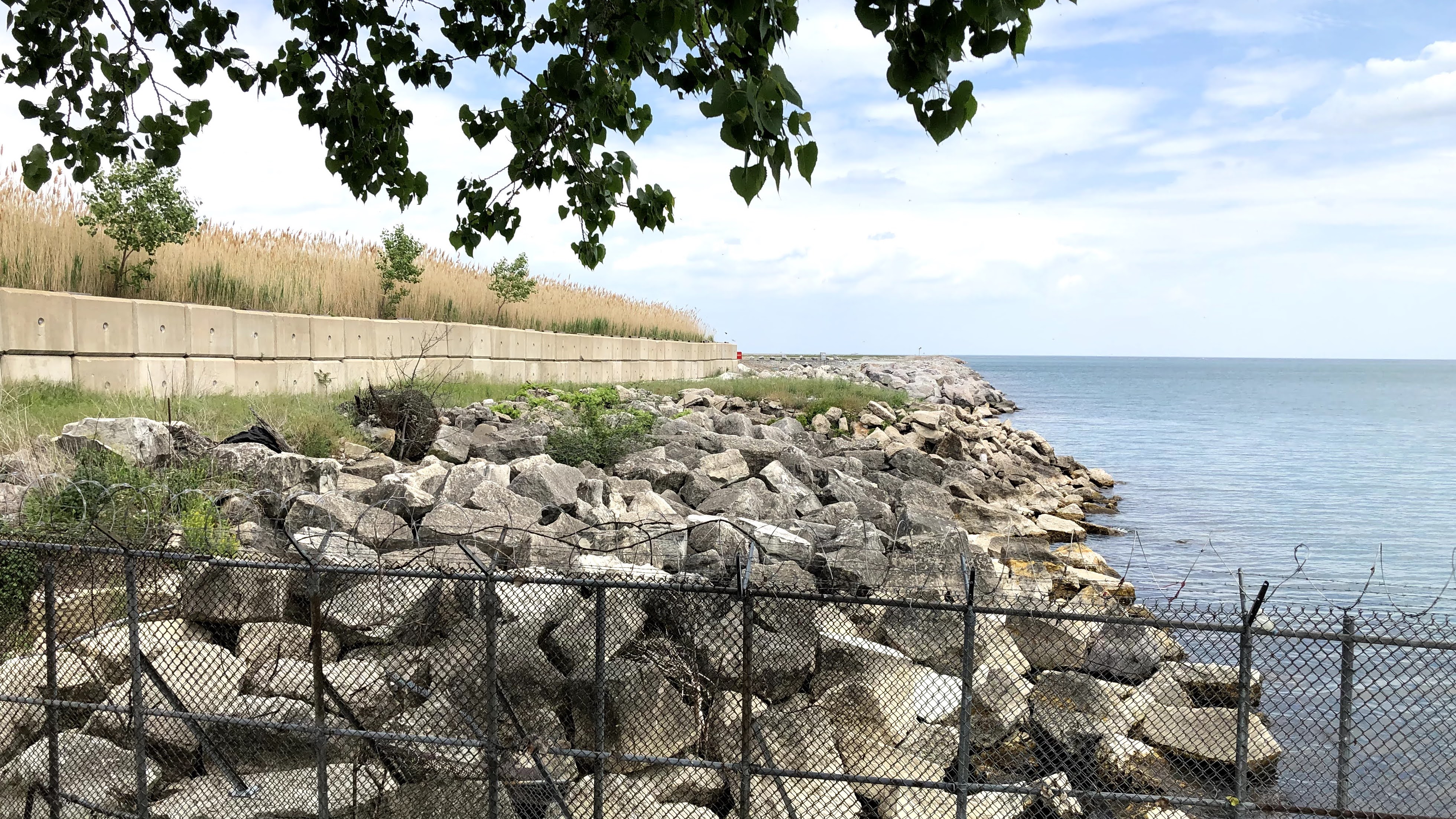
Most of this land is park space, hard won over decades by advocates inspired by Daniel Burnham’s 1909 Plan of Chicago. Often described as visionary and enlightened, the plan was also meant to facilitate business tycoons’ goals of creating wealth and reducing labor conflict. Parks were meant as recreational opportunities to divert working class laborers’ anger and resentment. Today’s concerns mostly center on extending public access along the privately owned sections north and south of the current lakefront trail, as well as addressing erosion and the increasing effects of climate change on lake levels.
Yet this land technically does not belong to the City, or to the public. As the Pokagon Band of Potawatomi insisted in a 1914 lawsuit against Chicago, the lakefill extends beyond treaty boundaries and thus was never ceded by Native people. What does it mean that this much-vaunted public lakefront was born from an elitist vision of urban control and breaks treaty law by its existence?
This audio piece contemplates the liminal space between land and water as simultaneously a public good, treaty violation, and strategy to suppress insurgence. Six audio tracks map onto locations along the Chicago lakefront at Berger Park, Belmont Harbor, Grant Park, 31st Street Beach, Jackson Park, and Calumet Park, meant to be listened to while walking, moving or simply being on this made land. Looking at how language creates place, even as place exceeds human language, Shore Land incorporates interviews, laws, treaties, stories, and songs in English, Potawatomi, and Korean.
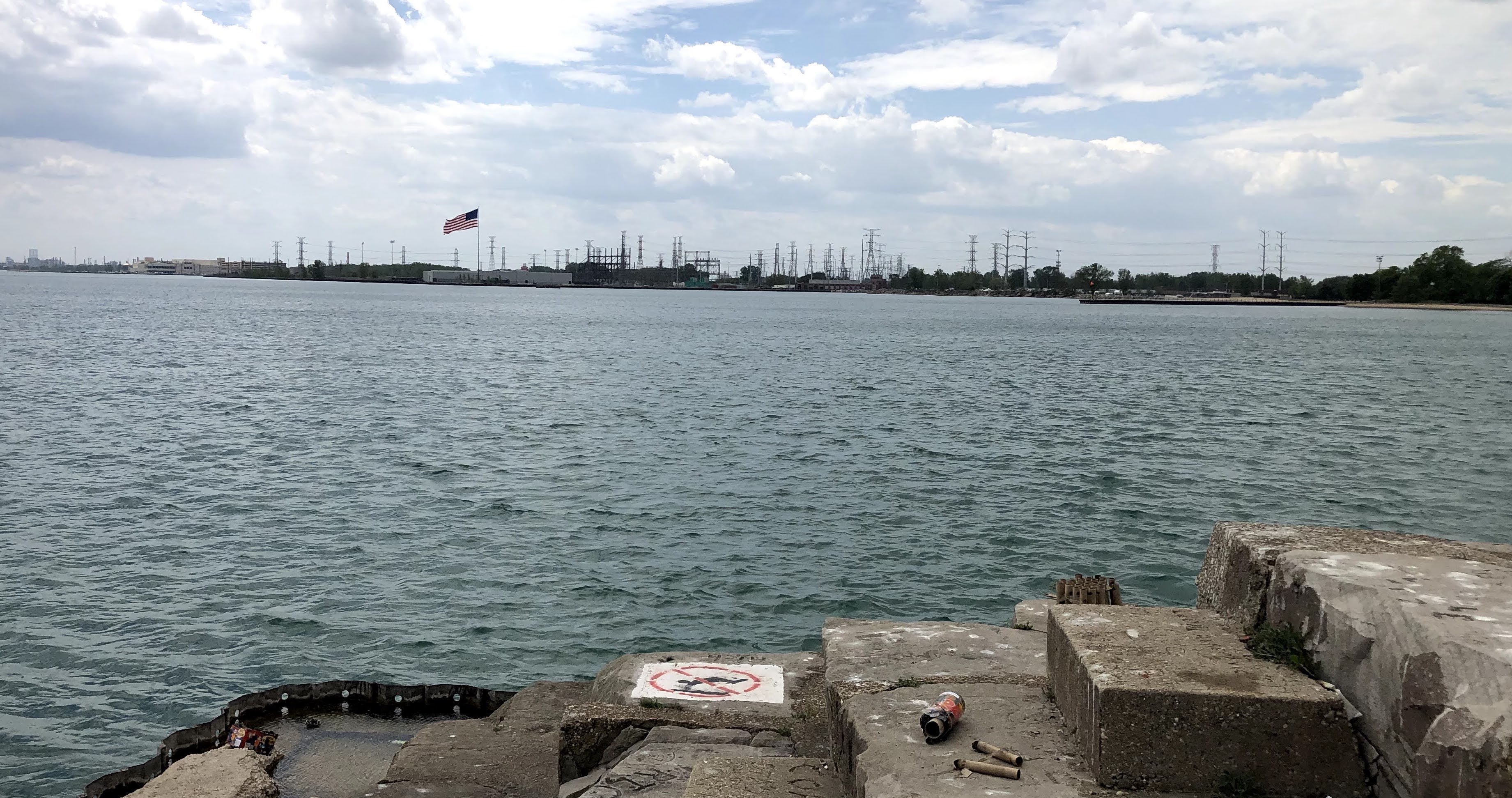
JeeYeun Lee is an interdisciplinary artist, writer, and activist based in occupied Potawatomi territory now known as Chicago. Through performance, objects, and socially engaged art, her work explores dynamics of connection, power, violence and resistance. Her work has been shown in Chicago, Detroit, Santa Fe, Ohio, Missouri, and France. She has worked with social justice and community-based organizations for over thirty years in immigrant rights, economic justice, LGBTQ issues, and domestic violence. She holds an M.F.A. in Fiber from Cranbrook Academy of Art, M.A. in Ethnic Studies from the University of California at Berkeley, and B.A. in Linguistics from Stanford University. For additional information, please visit jeeyeunlee.com.
This work is a part of Navigations, a series of artist projects in and about public space. This work has been supported by the Awesome Foundation (Chicago Chapter), the Puffin Foundation, the Individual Artist Program of the Chicago Department of Cultural Affairs and Special Events, Center for Cultural Power, and the School of the Art Institute of Chicago. In 2025, this project was supported by grants from the Illinois Arts Council Agency; CityArts grants from the City of Chicago Department of Cultural Affairs & Special Events; Cliff Dwellers Arts Foundation; Gaylord and Dorothy Donnelley Foundation; Reva and David Logan Foundation; Teiger Foundation; as well as in-kind support from Chicago Park District. In 2024, this program was supported by Hyde Park Art Center’s Artists Run Chicago Fund in partnership with Art Design Chicago, a citywide collaboration initiated by the Terra Foundation for American Art that highlights the city’s artistic heritage and creative communities. In 2023-24, this program were supported in part by federal assistance listing number 21.027 awarded to Roman Susan Art Foundation NFP by the US Treasury through the American Rescue Plan Coronavirus State and Local Fiscal Recovery Funds in the amount of $50,000, representing 17.5% of total project funding.
Shore Land was previewed at The Arts Club of Chicago in August 2021 and at MCA Chicago in May 2023. Elements of this work have been featured in the exhibitions Water in 2023 and Myth of the Organic City in 2024-2026 at 6018North, and From the Great Lakes to the Great Plains in 2025 at Bemis Center. The project was featured as a part of the Chicago Architecture Biennial in 2025. Group outings for Shore Land with Roman Susan have occurred on June 10, 2023; July 23, 2023; August 27, 2023; April 14, 2024; September 26, 2024; and October 19, 2025.
Transcripts
Berger Park (pdf)
Belmont Harbor (pdf)
Grant Park (pdf)
31st Street Beach (pdf)
Jackson Park (pdf)
Calumet Park (pdf)
Walking tours tell a very different story about Chicago and its lakefront | Chicago Tribune - August 10, 2023
Shore Land | City Cast Chicago - June 5, 2023
A Multitude of Stories | Newcity - October 27, 2022